============================================================================================================
JFK REVELATIONS . . ... JFK INSIGHTS . . . ... AN EPIPHANY OF TRUTH . . . ....
================================== UPDATED ON 06/26/2016 =========================================
Jack Kennedy – Half A Century of Images… 50 Years Later . . . .…
LIFE John F. Kennedy - 50 Years Later…
[ΞΞΞΞΞΞΞΞΞΞΞΞΞΞΞΞΞΞΞΞΞΞΞΞΞ]
Jack Kennedy – Half A Century of Images…
50 Years Later . . . .…

LIFE
JOHN F. KENNEDY - 50 YEARS LATER…
[ΞΞΞΞΞΞΞΞΞΞΞΞΞΞΞΞΞΞΞΞΞΞΞΞΞΞΞΞΞΞΞΞΞ]
[ΞΞΞΞΞΞΞΞΞΞΞΞΞΞΞΞΞΞΞΞΞΞΞΞΞΞΞΞΞΞΞΞΞΞΞΞΞΞΞΞΞΞΞ]
[ΞΞΞΞΞΞΞΞΞΞΞΞΞΞΞΞΞ] [ΞΞΞΞΞΞΞΞΞΞΞΞΞΞΞΞΞΞΞ] [ΞΞΞΞΞΞΞΞΞΞΞΞΞΞΞΞΞ]
[ΞΞΞΞΞΞΞΞΞΞΞΞΞΞΞΞΞ] [ΞΞΞΞΞΞΞΞΞΞΞΞΞΞ] JFK [ΞΞΞΞΞΞΞΞΞΞΞΞΞ] [ΞΞΞΞΞΞΞΞΞΞΞΞΞΞΞΞΞ]

[!]Jack Kennedy [American Photography - PBS ~ A Century of Images]} [1158x1458]} Craquelure»texturiz'd'wrap'd'}highacts}»
================================================

[!!]LIFE - The Day Kennedy Died (Jack'n'Jackie ~ Pg.31) [776x1057]} Coredblbdr²d}high»
================================================

[~]LIFE - The Day Kennedy Died (FrontCover)} 50 Years Later...[894x1052]@25}highcleanbdr'd}bcs»
================================================

[~]LIFE - The Day Kennedy Died (Life Cover Nov.29 1963 ~ Kennedy 1917 - 1963 [862x1048]@25} highbdr'd}abcs»}
Fifty years ago on November 22, 1963, in Dallas’s Dealey Plaza, John Fitzgerald Kennedy, the 35th President of the United States, was assassinated while traveling in a motorcade with his wife, Jacqueline…
================================================

[!]Rose Kennedy's Family Album ~ John Fitzgerald Kennedy (1917)} Pg.46}» [904x1072]@50%}high}»
================================================

[!]Rose Kennedy's Family Album ~ Joe, Joe Jr., Jack and Rosemary (1917)} Pg.47}» [1195x1451]@50%}high}acts»
================================================

[!!]Rose Kennedy's Family Album ~ (Pg.262)} [1179x1495]@50%}High}Acts²}⧽»
================================================

[!]Rose Kennedy's Family Album ~ Joe Jr. & Crew}» (Pg.304) [958x801]@50%}High}Acts²}»
================================================

[!]RKFA ~ Joe Jr. (Pg.312)} [1280x1773]@42%}Max}Acts⧽»
================================================

[!]LIFE - The Day Kennedy Died ~ Navy Jack (Pg.19)} 50 Years Later... [1272x1652]@40%}High}Acts}»
================================================

================================================

[!]LIFE - The Day Kennedy Died (PT-109 ~ Pg.18) [1271x942]@40%}HighActs}»
================================================

[!]LIFE - The Day Kennedy Died (PT-109 » Pg.18) [1271x898]@40%}HighActs}»
================================================


[!]RKFA~Pg.303}» Coconut Jack [1167x1497]@50%}High}Acts}⧽»
================================================

[!]Rose Kennedy's Family Album ~ Pg.330} Eunice, Jack, Moe & Teddy}[1212x947]}high}acts}»
================================================

================================================
The Kennedys had been our story: Jack and Jackie made the cover in his sailboat before they were married…
================================================

[~]LIFE - The Day Kennedy Died (Enter Jackie ~ Pg.22-23)} 50 Years Later...[1284x826]@20%}highbdr'd}bcs}»
================================================

[!]LIFE - The Day Kennedy Died (President Kennedy ~ Pg.24)} 50 Years Later... [1275x1666]@40%}high}»
================================================

[!]LIFE - The Day Kennedy Died (Jack'n'Jackie ~ Pg.25)}[1308x1659]@40%}highbdr'd}acts}»
================================================

[!]LIFE - The Day Kennedy Died (Starting a Family ~ Pg.26)} 50 Years Later... [1272x1658]@40%} highbdr'd}acts}»
================================================

[!]LIFE - The Day Kennedy Died (Starting a Family... Caroline ~ Pg.27) [1287x899]@40%}high}acts}»
================================================

[!]LIFE - The Day Kennedy Died (Starting a Family... ~ Pg.27) [1287x574]@40%} highacts}»
================================================

[!]LIFE - The Day Kennedy Died (Kennedy Family ~ Pg.37) [1278x830]@40%}highacts}»
================================================

[!]All About History - Issue No.5 (Pg.03)} [1275x968]@150%}highsharp}bcs}»
================================================

All About History - Isuue No.5_02 [1286x1246]@200%}highacts}»
================================================
================================================

[!]LIFE (1963) Pg.102 [1246x1181]@40%}high}acts³}»
================================================

[!]LIFE (1963) Pg.101..Cape Cod...[1195x916]@40%}highac²ts³}⧽»
================================================
He was a fresh-faced senator from Massachusetts, and the White House doors had remained open to LIFE throughout his presidency…

[!]LIFE - The Day Kennedy Died (Storm'n'd'WhiteHouse - Pg.32) [1272x1848]@200%}highfacts}»
================================================
[!]LIFE - The Day Kennedy Died (Storm'n'd'WhiteHouse - Pg.33...)}» [1255x1366]@40%}maxfabcs}»
================================================
[!]LIFE - The Day Kennedy Died (Storm'n'd'WhiteHouse ~ Pg.32)} [1275x1637]@142%}Highfabcts}»
================================================
[!]LIFE - The Day Kennedy Died (Triumps,Travails,&Tensions ~ Pg.34)} [1298x1669]@80%} highfabcts}»
================================================
[!]LIFE - The Day Kennedy Died (Presidential Campaign ~ Pg.29) [1302x1650]@40%} highfacts}»
================================================
[!]In remembrance of John F. Kennedy [1280×958]@24%} [maxblckbrdr'd]
================================================
[!]LIFE (1963) [Pg.24-5]Comp..}[1280x839]@22%}highac²ts³}⧽»
================================================
[!]LIFE (1963) Pg.26-27}» Comp..}» [1280x800]@22%}highac²ts³}»
================================================
[ΞΞΞΞΞΞΞΞΞΞΞΞΞΞΞΞΞΞΞΞΞΞΞΞΞΞΞΞΞ]
Abraham Zapruder…
=====================================
[ΞΞΞΞΞΞΞΞΞΞΞΞΞΞΞΞΞΞΞΞΞΞΞΞΞΞΞΞΞΞΞΞΞΞΞΞΞΞ]
TDKD)}Pg.90 Abraham Zapruder [1132x1464]@35%}high}acts}»
================================================
the Zapruder film… the hidden secret…
=======================================
[ΞΞΞΞΞΞΞΞΞΞΞΞΞΞΞΞΞΞΞΞΞΞΞΞΞΞΞΞΞΞΞΞΞΞΞΞΞΞ]
[ΞΞΞΞΞΞΞΞΞΞΞΞΞΞΞΞΞΞΞΞΞΞΞΞΞΞΞΞΞΞΞΞΞΞΞΞΞΞΞΞΞΞΞΞΞΞΞΞΞΞΞΞΞΞ]
ΞΞΞΞΞΞΞΞΞΞΞΞΞΞΞΞΞΞΞΞΞΞΞΞΞΞΞΞΞΞΞΞΞΞΞΞΞΞΞΞΞΞΞΞΞΞΞΞΞΞΞΞΞΞΞΞΞΞΞΞΞΞΞΞΞΞΞΞΞΞ]

[!]LIFE - The Day Kennedy Died [Zapruder Film] [Pg.80-1]} CompOverlay} [1288x835]@20%}high}acct}»
================================================
[!]LIFE - The Day Kennedy Died (Zapruder missing frames ~}» Pg.93)} [1280x1600]@38%}high}acts»
================================================
[!!]LIFE -}~» Zapruder Key Frames [Pg.82-3 Frames 155-6, 208-11,161,188,210,223]} [1280x836]@20%}high}acts}»
================================================
[!!]LIFE -}~» Zapruder Key Frames [Pg.84-5 Frames 228,262,285, 298]} [1280x830]@20%}high}act}»
================================================
[!!]LIFE -}~» Zapruder Key Frames [Pg.86-7 Frames 313,333,359 & 367]} [1280x836]@20%}high}acts}»
================================================
[!!!]LIFE -}~» Zapruder Key Frames [Pg.88-9 Frames 387,347,412&474]} [1280x836]@20%}high²}acts³}»
=======================================
================================================
[ΞΞΞΞΞΞΞΞΞΞΞΞΞΞΞΞΞΞΞΞΞΞΞΞΞΞΞΞΞΞΞΞΞΞΞΞΞΞΞΞΞΞΞΞ]
[ΞΞΞΞΞΞΞΞΞΞΞΞΞΞΞΞΞΞΞΞΞΞΞΞΞΞΞΞΞΞΞΞΞΞΞΞΞΞΞΞΞΞΞΞΞΞΞΞΞΞΞΞΞΞΞΞΞΞΞ]
[ΞΞΞΞΞΞΞΞΞΞΞΞΞΞΞΞΞΞΞΞΞΞΞΞΞΞΞΞΞΞΞΞΞΞΞΞΞΞΞΞΞΞΞΞΞΞΞΞΞΞΞΞΞΞΞΞΞΞΞΞΞΞΞΞΞΞΞΞ]
[ΞΞΞΞΞΞΞ]} The Fake Zapruder Film (9∶59) Through the Looking Glass… {[ΞΞΞΞΞΞΞ]
‾‾‾‾‾‾‾‾‾‾‾‾‾‾‾‾‾‾‾‾‾‾‾‾‾‾‾‾‾‾‾‾‾‾‾‾‾‾‾‾‾‾‾‾‾‾‾‾‾‾‾‾‾‾‾‾‾‾‾‾‾‾‾‾‾‾‾
The Fake Zapruder Film (9∶59) Through the Looking Glass… «{(Max 480p)[5BEsAkXVeVM]
https://www.youtube.com/watch?v=5BEsAkXVeVM
Uploaded on Oct 26, 2010
On November 22, 1963, U.S. President John F. Kennedy was shot and killed while traveling down Elm Street, Dallas, Texas, in an open car in a motorcade. Everyone agrees about that.
Many people think that agencies of the U.S. Government have lied about or covered up details of the assassination.
For three decades, people thought the best proof of foul play was a 27-second home movie of the assassination taken by a Dallas dressmaker, Abraham Zapruder. It shows JFK’s head being blasted backwards and to his left:
This seems to tell us that the shooter was in front of the car on the right side, on the “grassy knoll” (small hill) next to Elm Street. But the U.S. Government insisted that JFK was shot by just one man hiding in a building far behind the limousine.
Things get more complicated when we look at the film frame-by-frame. As the bullet hits, JFK’s head first moves forwards:
This makes things confusing. There seemed to be three possible explanations:
1. He was hit by two bullets at almost the same time (one from behind and then one from the front).
2. He was hit from behind, and a jet of brain matter exploding from the front caused his head to recoil backwards.
3. He was hit from behind and some sort of muscle reaction caused his head to fly backwards.
People tried to figure this out for three decades. Instead of clearing up the mystery, Zapruder’s film just made things more confusing.
In the 1990s, researchers started to realize that there was a fourth possible explanation. Zapruder’s film might also be a part of the lies and cover-up that agencies of the U.S. Government had weaved around the JFK assassination!
Scientists examined the Zapruder film. They found that, while most of it looks completely genuine, some of the images are impossible. They violate the laws of physics. They could not have come from Zapruder’s home movie camera.
Zapruder’s film is a very good forgery. It is almost perfect. Some mistakes took almost 40 years to find.
The scientists also proved that Zapruder’s film was not just changed a little bit. The whole film is a fake!
A movie film is just a strip of little photos (“frames”). The fake film was made by cutting and pasting real photos and film frames together to make new frames.
Because the Zapruder film is only 27 seconds long, less than 500 photos needed to be made. The forgers had almost a year to create them, before they were published. This was not difficult to do in 1963 and 1964. People had been creating high quality fake photos since the 1850s!
But what about the people who watched Zapruder’s film in the days after the assassination?
Film experts believe that a real film of the assassination was quickly altered on the evening of the assassination, using machines that could create Hollywood-style special effects (like Mary Poppins, created in 1964). Since the film was not shown on television, no one knows exactly what these people saw. But we do know that they described a film that is different to the film published in November 1964 as the “Zapruder Film”!
==========================================
[ΞΞΞΞΞΞΞ]} The Zapruder Film Mystery (85∶03) Doug Horne{[ΞΞΞΞΞΞΞ]
The Zapruder Film Mystery (85∶03) Doug Horne [Composite][969x717]}
The Zapruder Film Mystery (85∶03) Doug Horne «{(Max 480p)
e2filmsrevolution [Doug Horne,Peter Janney,Dino Brugioni]
https://www.youtube.com/watch?v=J_QIuu6hsAc
Published on Aug 15, 2014
While serving as chief analyst of military records at the Assassination Records Review Board in 1997, Douglas Horne discovered that the Zapruder Film was examined by the CIA’s National Photographic Interpretation Center two days after the assassination of President Kennedy.
In this film, Horne interviews legendary NPIC photo interpreter Dino Brugioni, who speaks for the first time about another NPIC examination of the film the day after the assassination. Brugioni didn’t know about the second examination and believes the Zapruder Film in the archives today is not the film he saw the day after the assassination.
Drawing on Volume 4 of his book “Inside the ARRB”, Doug Horne introduces the subject and presents his conclusions…
================================================
[ΞΞΞΞΞΞΞΞΞΞΞΞΞΞΞΞΞΞΞΞΞΞΞΞΞΞΞΞΞ]
[ΞΞΞΞΞΞΞ][Murder in Dealey Plaza – James Fetzer’s Zapruder Analysis][ΞΞΞΞΞΞΞ]
[!]Murder in Dealey Plaza - The Great Zapruder Film Hoax [1280x974]Rdx'Facts']High}⧽»
================================================

=====================================

=====================================
================================================
=====================================
================================================
[ΞΞΞΞΞΞΞ]}» d’Zapruder film… d’Hoax of the Century… «{[ΞΞΞΞΞΞΞ]
=====================================
================================================

The Great Zapruder Film Hoax [XCigDMyHisE] Jack White
‾‾‾‾‾‾‾‾‾‾‾‾‾‾‾‾‾‾‾‾‾‾‾‾‾‾‾‾‾‾‾‾‾‾‾‾‾‾‾‾‾‾‾‾‾‾‾‾‾‾‾‾‾‾‾‾‾‾‾‾‾‾‾‾‾‾‾
[ΞΞΞΞΞΞΞ]}» D’ZAPRUDER FILM… D’HOAX OF THE CENTURY… «{[ΞΞΞΞΞΞΞ]
The Great Zapruder Film Hoax (57∶33) ‘uv’d’Century – Jack White «{(Max 480p)
Brad Veilleux
https://www.youtube.com/watch?v=XCigDMyHisE «{[!!!
Published on Jul 20, 2012
Even this film has noticeable cuts and bruises. Our adversary will never stop diligently laboring to prevent us from learning the truth.
Watching the tremendous amount of the cover-up work done on the Internet today, one may begin to appreciate what the “Big Government” term really means.
Trying to estimate the cost of the cover-ups, one may come in touch with the physical embodiment of the abstract term “unlimited resources” and how deeply can affect everyone’s life those that own the money printing presses.
Better read the book:
http://www.amazon.com/The-Great-Zapru…
***
Uploaded and described by AlBoesch on Jul 5, 2009
“Scientists examined the Zapruder film. They found that, while most of it looks completely genuine, some of the images are impossible. They violate the laws of physics. They could not have come from Zapruders home movie camera.
Zapruders film is a very good forgery. It is almost perfect. Some mistakes took almost 40 years to find.
The scientists also proved that Zapruders film was not just changed a little bit. The whole film is a fake!
A movie film is just a strip of little photos (frames). The fake film was made by cutting and pasting real photos and film frames together to make new frames.
Because the Zapruder film is only 27 seconds long, less than 500 photos needed to be made. The forgers had almost a year to create them, before they were published. This was not difficult to do in 1963 and 1964. People had been creating high quality fake photos since the 1850s!
But what about the people who watched Zapruders film in the days after the assassination?
Film experts believe that a real film of the assassination was quickly altered on the evening of the assassination, using machines that could create Hollywood-style special effects (like Mary Poppins, created in 1964). Since the film was not shown on television, no one knows exactly what these people saw. But we do know that they described a film that is different to the film published in November 1964 as the Zapruder film!
In May 2003, scientists and researchers presented their latest findings at a conference in Duluth, Minnesota. This has now been described in a book, The Great Zapruder Film Hoax, published in September 2003.
The web pages below describe the best proofs that the Zapruder film is a fake. They describe some of the mistakes that the forgers made.
You can save any of these web pages by going to the File / Save As menu on your web browser. The images and small movie clips shown on each page will also be automatically saved with each web page.
If you want more details, please read The Great Zapruder Film Hoax. It contains much more information about the Zapruder film and its forgery. An earlier book, Murder in Dealey Plaza, has more information about the whole assassination and its cover-up.
In the end, you have to decide for yourself what to believe. But dont just believe what the U.S. Government tells you!
* * * * * * * * * * * * * * * * * * * * * * * * * * * * * * * * * * * * *
COPYRIGHT NOTICE: Video uploaded for nonprofit, educational purposes only under the “fair use” provision of U.S. Code, Title 17, section 107.”
Category, People & Blogs, License, Standard YouTube License
* * * * * * * * * * * * * * * * * * * * * * * * * * * * * * * * * * * * *
===========================================
================================================
================================================
================================================
================================================
[ΞΞΞΞΞΞΞΞΞΞΞΞΞΞΞΞΞΞΞΞΞΞΞΞΞΞΞΞΞ]
[ΞΞΞΞΞΞΞΞΞΞΞΞΞΞΞΞΞΞΞΞΞΞΞΞΞΞΞΞΞΞΞΞΞΞΞΞΞΞΞΞΞΞΞΞ]
[ΞΞΞΞΞΞΞΞΞΞΞΞΞΞ][…more info '2' follow…][ΞΞΞΞΞΞΞΞΞΞΞΞΞΞ]
[ΞΞΞΞΞΞΞ][… [https://JFKRevelations.wordpress.com] … ][ΞΞΞΞΞΞΞ]
[ΞΞΞΞΞΞΞ][… [http://www.JFKRevelations.yolasite.com] … ][ΞΞΞΞΞΞΞ]
FreeLance Graphics Design . . . ...
================================================
[!]LIFE (1963) Pg.104...Hyannis Port...[1224x1625]@40%}highacts}»
================================================
================================================
ANY CRITICAL WORK OF RESEARCH SHOULD STAND THE TEST OF TIME ... AND HOLD UP TO CRITICISM ... SO TO BE FAIR .... LET'S PUT IT UP TO THE TEST OF SUCH CRITICISM FROM JOSIAH THOMPSON ... AND JUDGE FOR YOURSELVES .... IF THE ANALYSIS IS VALID ...
Archived for Posterity ... Courtesy of [http://www.jfklancer.com/moorman_essay.html]
[This essay is a joint effort. I wrote it and bear the responsibility for any errors. But the concept came from the group and it was executed by the group. Thanks to Gary Mack for invaluable information and critical editing. Thanks to Bill Miller for creating some stunning visuals. Thanks to Barbara Junkkarinen for criticism and editing when her eyes still hurt from surgery. Thanks to Craig Lamson for his insights. We offer apologies in advance for the length of the piece. We mean it to be the definitive and last treatment of this issue. Josiah Thompson]
MOORMAN - IN - THE - STREET?
by Josiah Thompson
Preface
Try a simple experiment. Crank up Google and make a quick trip to the internet offerings on the Kennedy assassination. It’s like a visit to a carnival midway. Pitchman after pitchman is offering his or her wares. Over here you have somebody using a bad copy of the Zapruder film to show that Agent Greer turned around and shot JFK with a flashy chrome revolver. Over there is someone claiming George Bush was in Dealey Plaza or that Richard Nixon arranged the whole thing. Many film clips attempt to show that this or that photo from Dealey Plaza has been falsified by unknown conspirators. After a few minutes of this, you’ll come away convinced that the only way to keep up-to-date on developments in the case is by subscribing to one of the supermarket tabloids.
It wasn’t always like this. How did this change come about and what will be its likely outcome? I’ll try to answer the first question right off while leaving the second for the end of this essay.
In the years immediately after the assassination, things were different. There was no internet and there was an almost unanimous feeling in the country at large that the Warren Commission got it right. Those of us who questioned the official story were mindful of the larger picture and particularly careful to avoid mistakes. The early books on the assassination were carefully fact-checked and edited.. Mark Lane’s "Rush to Judgment" was worked over by numerous helpers in London, England. Edward Epstein’s book, "Inquest," started out as a master’s thesis at Cornell and hence was subject to scholarly discipline. For the rest of us... private individuals working on the assassination for a variety of reasons.. modesty of claim was the order of the day. We were willing... even eager... to have our claims vetted by other researchers. Those of us who challenged official opinion were meticulous about avoiding mistakes. Any mistake of fact or misinterpretation of evidence would be held against all of us. For this reason, articles or essays were fact-checked and discussed exhaustively before publication. Sylvia Meagher checked chapters of my "Six Seconds in Dallas" and I checked chapters of her "Accessories After the Fact," both before publication. Sylvia ended up doing the index for "Six Seconds."
Things are quite different now. The popularity of the internet and print-on-demand publishing have brought about a drop-off in research standards. There are exceptions. Books published by JFK Lancer, for example, are still fact-checked and copy-edited. But things took a decided turn for the worse with the publication of Professor Fetzer’s first book, "Assassination Science" in 1998. No longer was there a small community wherein opinions and theories could be vetted before publication. With a penchant for the tabloid style, Fetzer gave voice over the years to a number of researchers who competed with each other to produce dramatic (often outlandish) claims. As book followed book, Zapruder film alteration became the central focus of Fetzer’s promotion. Rather than doing research himself, Fetzer became the pitchman for this view. His tabloid style meant that nothing was checked in advance of publication. The basic idea was to publish first and ask questions later. This led to the collapse of many claims as soon as critical attention was paid to them.
Such was the fate of the claim that is the subject of this essay.
For some thirty-seven years, we all thought of Mary Moorman as the young woman seen in the Zapruder film snapping her Polaroid photo of JFK with the knoll in the background. Fetzer’s second book, "Murder in Dealey Plaza," made the astounding claim that she had actually taken her photo from the street. In tabloid style, Fetzer’s book proclaimed in headlines:
“MOORMAN POLAROID CONTAINS ABSOLUTE PROOF OF ZAPRUDER FILM TAMPERING.... MARY AND JEAN WERE NOT ON THE GRASS; THEREFORE, THE ZAPRUDER FILM IS FAKED”
Unchecked by anyone before publication, the claim was immediately challenged and shown to be simply another example of Jack White’s careless analyses.
Unique to the Moorman-in-the-street claim, however, is the commitment that White and Fetzer continue to make to it. Other mistakes of photo interpretation by White, if not admitted to be mistakes, are at least left to molder in the dust heap of unremarked and forgotten theories. With respect to Moorman-in-the-street, earlier believers in the claim, David Mantik and John Costella, threw in the towel long ago. John Costella recently lectured Fetzer on Fetzer’s mistakes of interpretation pointing out on 12/17/08 that “it has been established, without any doubt, that the extant Moorman Polaroid could NOT have been taken from the street... It is, in fact, completely consistent with the Zapruder film’s location of her lens.” [NOTE: Emphasis in original; see http://groups.yahoo.com/group/jfk-research/message/6147] A week earlier, Costella posted, “Just to bring everyone up to speed: I do NOT believe that the extant Moorman Polaroid places her on the street. In other words, I am on the Thompson et al. side of this argument, not Jim’s .” [NOTE: Emphasis in original; see http://groups.yahoo.com/group/jfk-research/message/5999.]
Yet over the last three months, Fetzer and White have continued to defend it with a steady stream of invective and irrelevant claims. The usual end of these debates is that one side or the other just gets tired of the invective and the issue dies unresolved. For me, however, dissatisfaction with the debate forced a series of questions: What if I ignored Fetzer’s invective and insults and pursued the whole question in a more scholarly manner? What if I treated it simply as a historical claim subject to reasoned argument and demonstrated fact? What if I offered in terms of thoroughness and logical rigor a demonstration of what real research looked like? Might not such a demonstration stand as a judgment over the shrill tone and tabloid style familiar to us? Even better, might not such a thorough job of research lead us into hitherto unexplored territory concerning that Friday so long ago? With the help of others, I answered these questions affirmatively and set to work.
Part I deals only with the Fetzer/White claim that a line-of-sight (LOS) in the Moorman photo proves it was not taken from the position Moorman occupied in the Zapruder, Nix, Muchmore and Bronson films. Part II will take up the Fetzer/White claim that Moorman took her photo from the street. Appendix A will lay out the various comments Moorman has made since 12:30 PM on November 22nd about her position in taking her photo. It will also evaluate the Fetzer/White claim that Moorman stated unequivocally from first to last that she took her photo from the street.
PART I.
1. Optics: what principle is involved?
The whole Fetzer/White claim hangs upon a simple principle of optics: If two objects in your visual field line up exactly, the eye that lines them up is on the same line-of-sight (LOS) as the two objects. A simple experiment shows this.
Look out your back window. See the top of that swing-set about 100 feet distant? Close your left eye and line up the right top of the swing set with the crotch of the tree some 35 feet beyond it? Your right eye, the right top of the swing set and the crotch of the tree beyond form a straight line... that is, a line-of-sight (LOS). That’s why it’s called “a line-of-sight.” Now substitute a camera lens or surveyor’s transit for your right eye. If you take a photo with the camera, the right top of the swing set and the crotch in the tree will exactly line up. The LOS formed by lining up these two objects will have a different height above the ground as the ground curves up and down between your position and the top of the swing set. By dropping a tape to the ground along that line, you can determine the height of the LOS above the ground at any point. Hence, at any point along that line, you can take a photo showing that the two objects remain aligned and then measure with a tape the height of the center of the camera lens above the ground. Note too that by moving around you can line up any number of objects thus identifying with your eye any number of “lines-of-sight” (LOS).
There is nothing in the Fetzer/White claim more complicated than this simple principle.
2. What is the Fetzer/White claim?
The first appearance of the Fetzer/White claim known to me occurs in Fetzer’s book, "Murder in Dealey Plaza." In a special photo section put together by White, Fetzer announces the claim in his usual style, “MOORMAN POLAROID PHOTO CONTAINS ABSOLUTE PROOF OF ZAPRUDER FILM TAMPERING.” White points out that since the Moorman photo was clearly “genuine” he might be able to use it to prove the inauthenticity of the Zapruder film. “I discovered a point within the photo,” writes White, “that aligned two widely disparate points such that their alignment established that unique line-of-sight. At the left is a graphic image of the two points of reference I aligned, which are easily located in the plaza. Two edges of the window openings in the rear of the paragola (sic) (A and B) in the photo exactly coincide with the top and south edge of the pedestal (C and D). As you can see, the angles AB and CD form a large cross (+), which is readily perceived across Elm where Moorman stood to take her picture.” If we look at the enlargement from the Moorman photo that Fetzer and White used to illustrate their claim, White’s verbal description may become clearer.

White speaks of “two widely disparate points such that their alignment established that unique line-of -sight.” What are those “two widely disparate points?”
Since White also describes the points as being made up of the coincidence of four lines and two angles, we can use this description to identify the points he refers to. Line C is the top of the Zapruder pedestal; line D is the southwest (or left) edge of the Zapruder pedestal; line B is the bottom of the pergola window; line A is the northeast (or right) edge of the pergola window. Since White says that the coincidence of the two angles forms the cross (A, B, C, D) indicated, we can say with confidence that the two points he referred to are the left top corner of the Zapruder pedestal and the right bottom corner of the pergola window beyond. Alternatively, but more awkwardly, one could say that the LOS is formed by the lining up of lines B and C, of lines A and D, and the cross formed by their intersection.
Jack White took David Mantik to Dealey Plaza and showed him what he had found. Mantik later related in Fetzer’s book how “astonished” he had been by White’s discovery:
It was possible to locate Moorman (actually Moorman’s eye) [(sic) It’s not her“eye.” It’s the lens of her camera which is 2.25" below the viewfinder.] very precisely at the moment she took her picture. Although her distance from the arcade remained uncertain, her lateral and vertical position could be determined quite exactly. When I attempted to reproduce this, I was astonished. As I lined up one corner of the pedestal with a chosen point on the background arcade [the bottom right corner of the window], I could immediately see that this technique was exquisitely sensitive to even slight head movements. The smallest movement of my head put it out of alignment.” (MIDP, 344)
White returned to the claim in Fetzer’s next book, The Great Zapruder Film Hoax, but added no significant new information to buttress it. In introducing White’s brief section, Fetzer had this to say about it:
Few incidents in the history of the study of the death of JFK have provoked such strenuous disputation as that over Jack White’s observation that certain structural features of the Dealey Plaza pergola provided a line-of-sight present in the Moorman that should permit a determination of Mary’s location at the time she took her famous photo. These features are the left-hand side and the top of the pedestal from which Abraham Zapruder was allegedly taking his film and the bottom and right-hand side of the window behind them. These features create two points in space that are located approximately 35 feet apart, generating an imaginary line to the lens of her camera about 100 feet away.*
[*NOTE: Fetzer then adds to his introductory remarks the following caveat: “A minor structural indentation at the top of the pedestal has misled some to think that the intersection of these lines is indeterminate, but that is a mistake.” Fetzer is correct that the left edge of the pedestal has a setback of approximately one inch around its top. Since this setback only affects Moorman’s lateral position by a few inches and not the height of her lens above the ground, no one has been “misled” by its presence. John Costella has called this caveat by Fetzer “irrelevant.”]
As Fetzer points out, the importance of White’s observation is that the “two points in space... located 35 feet apart generate an imaginary line to the lens of her camera about 100 feet away.” In MIDP, White states that this “imaginary line” places her camera 44.5" above the ground. This height above the ground for her camera is much lower than it appears in the Zapruder film. White and Fetzer conclude that they have discovered indisputable proof that “the Zapruder film is faked.”
3. The “White LOS” vs. the “Moorman LOS”
Based as it is on a simple principle of optics, if Fetzer and White are correct about the LOS present in the Moorman photo, their conclusion follows necessarily. Their proof, however, depends upon the claim that (what we might call) the “White LOS” really is found in the Moorman photo. The fact that anyone can go to Dealey Plaza and line up any two objects with one’s eye is true but unenlightening. If the lining up of two objects is to establish the position of Moorman’s camera, the same alignment of the two objects has to appear in the Moorman photo. Fetzer and White have claimed unequivocally that the left top corner of the Zapruder pedestal lines up with the bottom right corner of pergola window. If they are correct in this observation, there is a huge discrepancy between the Zapruder film and the Moorman photo.
Are they correct?
Recall that the Moorman photo enlargement placed in MIDP by White and Fetzer had a wide, red cross superimposed on the enlargement. Their point was to illustrate the alignment of what White called “the two widely disparate points such that their alignment established that unique line-of-sight.” The cross, however, covered up precisely what it was meant to illustrate... the alignment of the two points. The copy of the Moorman photo used by Fetzer and White in this illustration is easily recognizable; hence, the “cross” can be removed and we can see what is underneath it. Do the two points align exactly or not?
![Copy of the Moorman photo used by Fetzer and White in this illustration is easily recognizable][Red lines and without...](resources/Copy%20of%20the%20Moorman%20photo%20used%20by%20Fetzer%20and%20White%20in%20this%20illustration%20is%20easily%20recognizable%5D%5BRed%20lines%20and%20without.jpg)
No, they don’t. The top of the pedestal is significantly below the bottom of the pergola window and to the right of the bottom of the pergola window. The left side of the pedestal is to the right (or east) of the side of the pergola window. Or to put it another way, White’s “angle” formed by the lines A-B is above and to the left of his angle formed by the lines C-D. Indisputably, the left front corner of the Zapruder pedestal does not line up with the bottom right corner of the pergola window beyond. There is a significant “gap” between the two. What Fetzer and White have claimed is simply untrue.
So what does this mean?
It means that there are actually two relevant lines-of-sight. There is the “White LOS” formed by the alignment of the two points (or two angles or four lines, depending on how you want to describe it). This LOS is not to be found in the Moorman photo. The actual “Moorman LOS” is quite different.
If one goes to Dealey Plaza with a copy of the Moorman photo one can readily find both the “White LOS” and the “Moorman LOS.” Here’s how to do it: In Dealey Plaza, line up the left top corner of the Zapruder pedestal with the bottom right corner of the pergola window beyond. You have now identified the “White LOS.” Next move your head a few inches to the left (or west) and then lift your head seven or eight inches higher. You will now have identified the real “Moorman LOS”... that is, the actual LOS present in the Moorman photo. Make no mistake, that “seven or eight inches higher” is crucial for it brings the height of Moorman’s camera into coincidence with its position as shown in the Zapruder film. It also brings Moorman’s camera and her own position into coincidence with what we see in the Nix, Muchmore and Bronson films.
4. The Fetzer/White Defense
Fetzer began his most recent defense of this claim on the JFK-research site, a Yahoo group, (NOTE: See <http://groups.yahoo.com/group/jfk-research/message/5869>.) He quickly made clear what he has announced in other venues over the years. Despite the overwhelming obviousness of their mistake, Fetzer and White have refused to admit any error. They have insisted now for over a decade that the “White LOS” is in fact the “Moorman LOS” and that this proves the alteration of the Zapruder film. They have claimed that the “drum scan” copy of the Moorman photo has been faked up by Josiah Thompson. They have claimed that all copies of the Moorman photos have been faked up by persons unknown to put Zapruder and Sitzman on the pedestal when they weren’t really there. Repeatedly and characteristically they have claimed that their critics are part of some grand plot to keep the truth about the Kennedy assassination from the American people.
Instead of treating their particular defenses in serial order, it will be more economical of time and effort to treat their defense effort as a whole. First, it is important to lay out a few non-controversial facts.
Examination of the Zapruder film shows that Moorman was standing with the heels of her shoes approximately 24" from the south curb of Elm Street. She is holding the camera up to her face with the viewfinder to her right eye. Her eyes are approximately 5" below the top of her head. The viewfinder is 2.25" above the lens of the camera. Her legs are somewhat spread and her shoulders hunched forward as she takes her photo. In 1963, Moorman was between 5' 0" and 5' 1."
![Examination of the Zapruder film shows Moorman][z305 cropped for Moorman...](resources/Examination%20of%20the%20Zapruder%20film%20shows%20Moorman%5D%5Bz305%20cropped%20for%20Moorman.jpg)
Not only did Fetzer and White fail to accurately identify Moorman’s position with respect to the Moorman LOS, they have also failed to get her position correct as it is shown in the Zapruder film. They have repeatedly said that she was standing two feet from the curb. This is the position of the back of her heels. The camera lens, however, is 5" forward of the viewfinder through which she is looking and her shoulders are hunched somewhat forward. Hence, the true position of the lens is within a few inches of the curb, not two feet. The turf slopes slightly upward from the edge of the curb and is sometimes soft and squishy. In addition, the Sixth Floor Museum has a photo showing that the spot where Moorman stood was torn up and replaced with new turf late in 1966. Therefore, measurements made above the turf at Moorman’s position in 2000 or 2002 can NOT be assumed to be precise. Alternatively, measurements taken over the curb can be considered probative.
In 1963, 2000 and 2002, the turf sloped upward from the curb. As stated above, Jack White measured the “White LOS” as being 44.5" above the turf at Moorman’s position. Later, White, Fetzer and Mantik returned to Dealey Plaza with a transit and measured the height of the “White LOS” as 41.5" above the turf. Since, in neither case, did White or Fetzer take photos recording what exact LOS they were measuring, I have no idea whether these figures are correct. Nor do I understand why they should vary by 3". Had White made measurements over the curb and written down the results, we would know more. David Mantik took notes of their “transit” visit to Dealey Plaza and noted that their LOS crossed the curb at a height of 48.25" Since Gary Mack and I recorded the “White LOS” as crossing the curb at a height of 48," Mantik’s and our figures match for the height of the “White LOS” over the curb. Unlike Fetzer and White, Gary Mack and I took photos at the heights we measured over the curb. Although the “White LOS” crossed the curb at a height of 48" the actual “Moorman LOS” crossed the curb at a height of 55.75". Gary Mack and I also replicated the Moorman photo from a position in the turf a foot back from the curb. The center of the camera lens in that location was 53.75" above the turf.
![View from the Grass blowup][Moorman versus Mack Thompson...](resources/View%20from%20the%20Grass%20blowup%5D%5BMoorman%20versus%20Mack%20Thompson.jpg)
Fetzer and White continue to claim that the “White LOS” is the same as the “Moorman LOS.” In other words, they continue to claim that the two points (or two angles or four lines) line up perfectly. When a single Moorman copy is presented to them, they claim that it has been altered to disprove their claim. The fact that all the extant copies of the Moorman photo show exactly the same thing means that none have been altered. The “White LOS” is not in the Moorman photo. This can be seen in a comparison of various Moorman copies with a White photo that shows the “White LOS.”
Archived for Posterity ... Courtesy of [http://www.jfklancer.com/moorman_essay.html]]
Archived for Posterity ... Courtesy of [http://www.jfklancer.com/moorman_essay/moorman_essay_2.html]
=================================================================
MOORMAN - IN - THE - STREET?
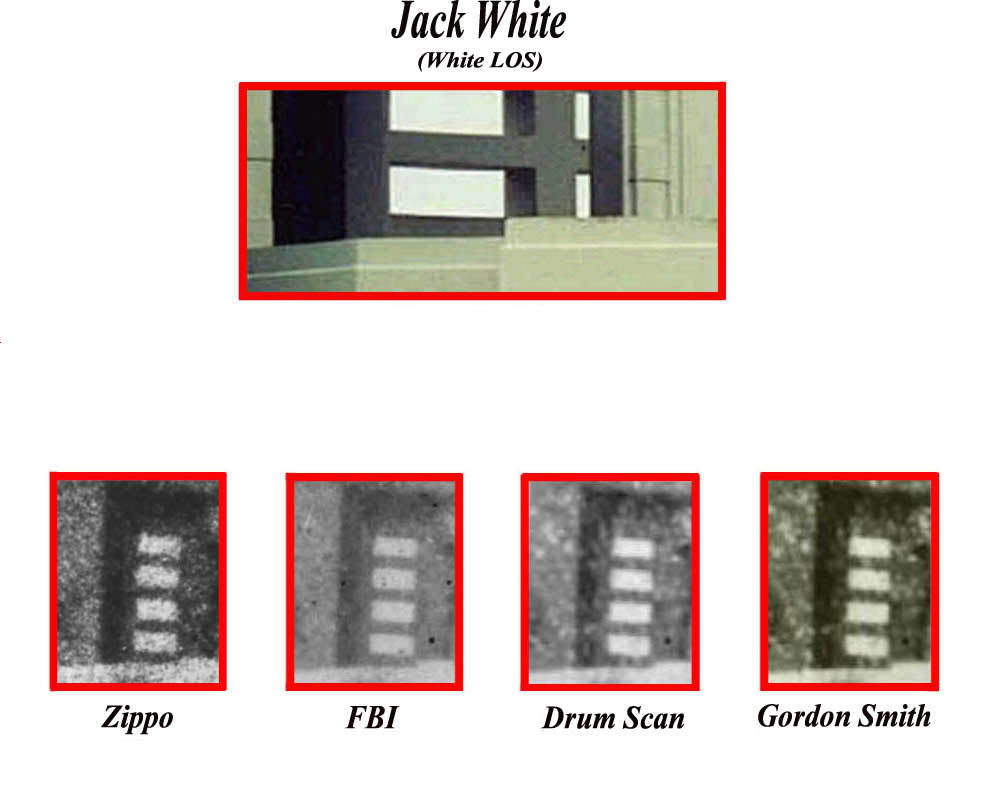
5. Copies of the Moorman Polaroid
Given the fact that all extant copies of the Moorman Polaroid show the same thing and that “same thing” falsifies the Fetzer/White LOS theory, it is no wonder that Fetzer and White next attempted to cast doubt on the authenticity of the copies. At first, they only accused the so-called “drum scan” copy of being altered by me. Later, however, when it turned out that this copy matched all the others, they expanded their claim to embrace all copies of the Moorman photo. They further alleged that the copies had been altered in one particular area... that of the Zapruder pedestal and the window beyond. Why? Was this done just to give critics forty years later grounds for doubting their claim, a claim that depended both on the authenticity of the Moorman photo and on a particular relationship between the pedestal and the window? No, that would be a stretch. In their theory, the Moorman photo was altered to conceal the fact that neither Sitzman nor Zapruder stood on the pedestal that day. And what about the Willis, Bronson and Betzner photos that show two similarly-dressed people on the pedestal? They were altered too.
In any case, their attempt to impeach the authenticity of the Moorman copies led to fascinating research as to how and when the copies were made. This research will be the focus of this section.
UPI COPY
After taking her famous photo, Mary Moorman moved back from the curb and dropped to the grass along with her friend, Jean Hill. Several photos and a WFAA news film show them sitting there. Later that afternoon, Moorman executed a Sheriff’s Department affidavit where she says, “When I heard these shots ring out, I fell to the ground to keep from being hit myself.” (19H487)
![Seconds later, photos show Jean Hill’s red coat flaring as she runs up the steps of the grassy knoll][Bond photo...](resources/Seconds%20later%2C%20photos%20show%20Jean%20Hill%E2%80%99s%20red%20coat%20flaring%20as%20she%20runs%20up%20the%20steps%20of%20the%20grassy%20knoll%5D%5BBond%20photo.jpg)
Seconds later, photos show Jean Hill’s red coat flaring as she runs up the steps of the grassy knoll. Moorman stayed on the grass. Moments later, Hill returned to find Moorman, standing at her original position and talking with James Featherston, court reporter for the "Dallas Times-Herald." In 1993, Featherston told a reporters’ gathering what had been in his mind, “I wanted that picture, period. At the time, I thought that was the only picture in existence. Mary agreed to give me the film. I asked both of them to come back to the press room with me – which they did.” [NOTE: See ”Remarks by James Featherston at 'Reporters Remember Conference', Dallas, 11/20/93,” cited in "Pictures of the Pain" by Richard B. Trask (Danvers, Mass.: Yeoman Press, 1994), page 237.] Featherston spoke with the two women as they walked to Moorman’s car where she coated the Polaroids. Then he shepherded them to the “press room” in the Criminal Courts Building at the northeast corner of Main and Houston Streets. As he did all this, Featherston got their story. He also got from Moorman permission to copy her photo. Once in the press room, Featherston called his editor, Tom LePere, and gave him a run-down on what the two women had told him. The editor sent a runner over to pick up Moorman’s photo for copying and asked another reporter, Connie Watson, to take down Moorman’s and Hill’s stories over the phone.
Barb Junkkarinen is acquainted with Watson (now Kritzberg) and talked to her last week. Kritzberg recalled that Moorman clearly was upset that afternoon. “Stunned silence” were the words Kritzberg used in describing Moorman at the beginning of their talk. Kritzberg could not recall if Moorman said anything about where she was when she took her photo. Moorman didn’t remember how she got onto the ground and commented that she hadn’t seen anything since her eye was pressed to the viewfinder. In her book, Kritzberg commented that Moorman told her she “sank to the ground, or perhaps was pulled down.” (NOTE: Connie Kritzberg, "Secrets from the Sixth Floor Window", (Undercover Press, 1994), page 15.)
The "Dallas Times-Herald" shared a photo lab with UPI who immediately distributed the picture to newsrooms the afternoon of the 22nd. A copy negative of the Moorman photo was made by an unknown employee and quickly returned to Moorman via Featherston. The "Times-Herald" then published the picture on Sunday, November 24. UPI purchased distribution rights to the photo from Moorman several days later. Through this distribution, the Moorman photo became an iconic representation of the assassination. The UPI copy, however, was usually cropped for distribution. Missing was the right side of the Polaroid print that shows Zapruder and Sitzman on the pedestal. In 1967, I searched in the files of UPI for the original copy negative and any full-frame prints. I found none. To my knowledge, neither the negative nor any prints of the uncropped Polaroid are extant in the UPI (now Corbis) files. The following photo came from the files of UPI and was used in producing the book, "Four Days in November."
![Photo shows that a full-frame Moorman photo was distributed on the UPI wire on November 23, 1963][UPI copy Preston original...](resources/Photo%20shows%20that%20a%20full-frame%20Moorman%20photo%20was%20distributed%20on%20the%20UPI%20wire%20on%20November%2023%2C%201963%5D%5BUPI%20copy%20Preston%20original.jpg.opt818x663o0%2C0s818x663.jpg)
The following photo shows that a full-frame Moorman photo was distributed on the UPI wire on November 23, 1963.
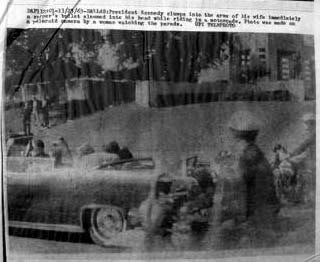
NBC –TV Copy
The Moorman Polaroid was only absent from the Press Room for a short time while being copied at the "Dallas Times-Herald"/UPI photo lab. It was returned promptly to Moorman and was in her possession for an interview with NBC that occurred around 1:00 PM. A shot of her Polaroid was part of that interview and became one of the first photos of the assassination to be seen nationally when it was broadcast at 3:19 PM (CST) on the NBC network.
![Gary Mack interviewed the freelance TV reporter who did the interview, Henry Kokojan][Moorman-NBC]](resources/Gary%20Mack%20interviewed%20the%20freelance%20TV%20reporter%20who%20did%20the%20interview%2C%20Henry%20Kokojan%5D%5BMoorman-NBC.jpg)
Gary Mack interviewed the freelance TV reporter who did the interview, Henry Kokojan. Kokojan had filmed the motorcade from the Adolphus Hotel when it passed on Main Street and went to Dealey Plaza immediately after learning what happened. He was working for NBC News that day and their local affiliate was WBAP-TV (now KXAS-TV). Unlike most of the news photographers, Kokojan had one of the few sound-equipped cameras. He was shooting black & white, 16 mm film, the standard for TV news in those days. After doing his interview with Moorman and Hill, he made his way to Parkland Hospital where he ran into NBC News photographer Dave Wiegman and WBAP photographer Bob Welch. All three had film and they wanted to get it processed and on the air. Either using a phone or Welch’s two-way car radio, they called WBAP and requested a runner to take their film to the station about 25 miles away in East Ft. Worth. This was done as quickly as possible and the film developed in the WBAP photo lab. It was put on the air at 3:18 PM fresh from the TV station’s processor.
![Moorman Polaroid [NBC 11-22-63]](resources/Moorman%20Polaroid%20%5BNBC%2011-22-63%5D.jpg)
AP/“ZIPPO” COPY
A full-frame photo shows the Moorman Polaroid propped-up against a wall with a Zippo lighter along the right frame border.... hence the name “Zippo copy.”
![Moorman Polaroid propped-up against a wall with a Zippo lighter along the right frame border][Zippo image...](resources/Moorman%20Polaroid%20propped-up%20against%20a%20wall%20with%20a%20Zippo%20lighter%20along%20the%20right%20frame%20border%5D%5BZippo%20image.jpg)
This photo was taken by an unknown law enforcement officer without Moorman’s knowledge on the afternoon of November 22nd while she was being questioned. It was taken with an inexpensive “box camera” that used standard, grainy film. Therefore, enlargements from this negative are plagued by grain breakup and are of low resolution. As John Costella has pointed out, this is the “blurriest” of all Moorman copies. A copy from this version eventually found its way to the Associated Press and was distributed on the AP wire within a few days.
![Copy from this version eventually found its way to the Associated Press and was distributed on the AP wire within a few days][Wide World Zippo with text full frame...](resources/Copy%20from%20this%20version%20eventually%20found%20its%20way%20to%20the%20Associated%20Press%20and%20was%20distributed%20on%20the%20AP%20wire%20within%20a%20few%20days%5D%5BWide%20World%20Zippo%20with%20text%20full%20frame.jpg.opt786x594o0%2C0s786x594.jpg)
FBI COPY
The FBI report of a 11/22/63 interview with Moorman ends with the remark “she furnished this photograph to bureau agents.” This may mean that she permitted the agents to view the photo or it may mean that she let them borrow it at this time. Either on November 22nd (or very soon thereafter), the FBI obtained Moorman’s photo and copied it. That copy languished in the files of the FBI Dallas field office for two decades.
In the early 1980s, Gary Mack was working with Jack White on their “Badge Man” theory. He was employed at KXAS-TV, the successor to WBAP-TV, the NBC station in Dallas-Ft. Worth. One of their reporters was curious, so Mack told him they were searching for better source material. The reporter, Ed Martelle, wondered if the FBI had a copy and contacted the Dallas FBI office. A copy was made of the Moorman photo and delivered to the reporter who gave it to Mack. He loaned it to Jack White who then made copies that he retained. The FBI print shows the entire Moorman photograph.
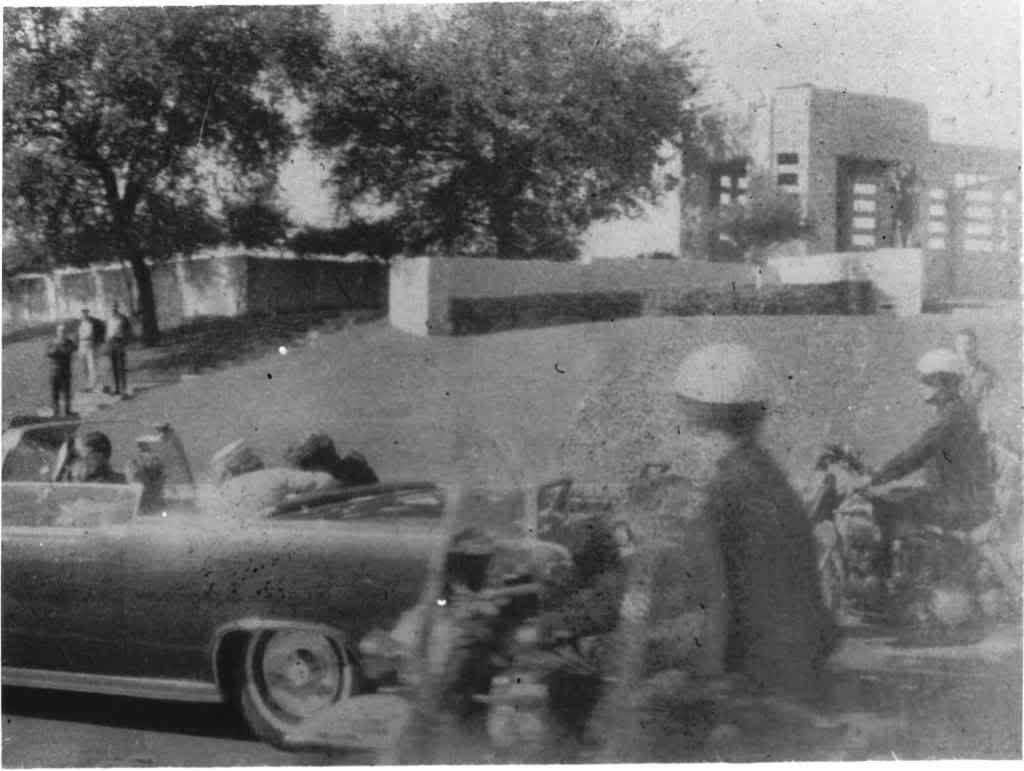
DRUM SCAN COPY
The Moorman photo became important to me during the production of "Six Seconds in Dallas" because it showed an anomalous shape along the stockade fence approximately fifteen feet west of the corner. Consequently, I searched various photo agencies for the best copies of the photograph. In addition, I contacted Mary Moorman and paid her to permit a Dallas professional photographer to copy her Polaroid. It was copied in February 1967 using a camera that produced 4" by 5" negatives even larger than the original Polaroid print. The photographer used those negatives to make several 8" by 10" prints.
In 1985, long before the Moorman-in-the-street controversy arose, I sent to Gary Mack and Jack White seven (7) copies of the Moorman photo from various sources. Included in this group of photos was an 8" by 10" print made by the professional photographer from his copy negative of the Moorman Polaroid. Jack White copied that 8” by 10" print and has retained a copy.
In January 2002, when Moorman-in-the-street came into controversy, I had the photographer’s original copy negative (not a print) scanned at 2400 dpi by Octagon Digital Media in San Francisco. Using a drum scanner on the original negative avoided any defects or artifacts introduced during the printing process. The work wasn’t cheap. CDs with the results of that scan were then distributed to anyone who wanted one including Jack White and James Fetzer. This scan was used by Joe Durnavich in his pixel-counting calculation using a method developed by John Costella. That calculation showed that the “Moorman LOS” was approximately seven inches higher at Moorman’s location than the “White LOS.” [NOTE: Durnavich’s study can be found at http://home.earthlink.net/~joejd/jfk/mgap/index.html. In making his calculation, he was able to identify more than 50 data points along the top of the pedestal... a fair indication of the precision of his calculation.]
Given the deterioration of the original Polaroid print both before and after February 1967 and the cropped nature of the UPI print, the drum scan copy of the Moorman photo may be one of the highest resolution copies in existence. Unfortunately, even by 1967 the badly deteriorated Polaroid had lost a lot of detail as indicated by the fingerprint that mars its surface.
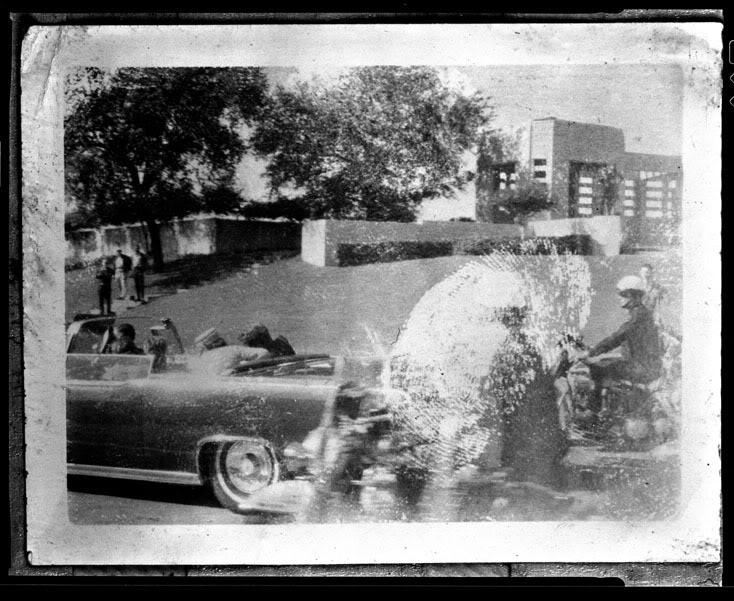
GORDON SMITH COPY
This copy originates with Jack White and Gary Mack. In the mid-1980s, White asked a photographer friend of his, Gordon Smith, to copy the Moorman Polaroid. Mack arranged with Moorman to borrow the Polaroid and the Moorman camera. Smith, whose photography studio also provided “restoration” of faded pictures, did so and turned the results over to White. Since then, White has posted this copy several times on the internet. It is clear that between 1967 and 1985 (when this copy was made) the Polaroid original had decayed further.
All of these copies have been generally available for decades. All have been in the possession of White and Fetzer since the beginning of the controversy. Yet all copies show the same thing when compared with what White claims to be the case. GIFs prepared by Bill Miller make this point abundantly clear.
In terms of the correct LOS, White and Fetzer failed to locate Moorman’s camera position accurately in all three dimensions. Laterally, they placed the camera too far to the right (east). Vertically they placed it too low. Finally, they judged the lens of the camera to be two feet back from the curb when, in fact, it was only inches. This latter mistake compounded the vertical error since the LOS maintains a downward slope while the grass verge slopes upward from the street.
This is ... JFK Lancer...
-----------------------------------
===============================
[http://www.jfklancer.com/moorman_essay/moorman_essay_3.html]
MOORMAN - IN - THE - STREET?
PART II
From Fetzer and White’s perspective, White’s mistaken LOS observation led to the conclusion that Moorman could not have taken her photo from a position in the grass beside the curb. Immediately, Fetzer and White were faced with an obvious question. She took her photo from somewhere. If a position on the grass by Elm Street was too low, from where did she take it? Of course, she took it from the street! It was 8" lower than the grass!
A quick scramble to check some of her interviews added some confirmation. Thirty-four years after the event (1997), Moorman said in a Dallas radio interview that she took her photo from the street. On the afternoon of the shooting, Moorman said something that might be construed to mean that. “So that must be it,” thought Fetzer and White, “she took her photo from the street and the fabricators of the Zapruder film moved her above the curb to the grass along Elm Street.” But why? Why would Mary Moorman being in the street or in the grass become of such importance to the conspirators that they would go to the great trouble falsifying the Zapruder and other films? Well, that’s not clear... But we can’t be expected to know everything. Maybe the conspirators had something else to cover up and this just became part of it.
In some fashion like this, the Moorman-in-the-street theory was born. Is it remotely plausible?
Think for a moment exactly what is being proposed.
The James Altgens photo taken at Zapruder frame 255 and showing the shadows of Moorman and Hill standing in the grass, show how crowded Elm Street was as the limousine passed.
An earlier sweep by motorcycle officers was designed to move stray spectators out of the roadway. Two motorcycles on each side of the limousine patrolled the sides of the roadway. As the Altgens photo dramatically shows, the motorcycle outriders accompanying the limousine came within thirty inches of the south curb of Elm Street. If we are to believe that Mary Moorman jumped into the street to take her famous photo, we also have to believe that those officers, Martin and Hargis, veered their cycles suddenly to the right to miss her. Furthermore, this happened right in the middle of the assassination when spectators’ attention was riveted on the motorcade. Not a single witness later reported anything like this. Not a single witness reported seeing a spectator leap into street and almost get run down by two motorcyclists. Both Officers Martin and Hargis made reports and were later interviewed several times. Neither one said a thing about some crazy woman jumping into their path in the middle of the shooting and their having to veer around her. Is it remotely plausible that this happened and no one saw it or reported it?
What do the other photos of the assassination show?
The Nix, Muchmore and Bronson films all show the same thing that the Zapruder film shows. Martin and Hargis never veer their motorcycles but maintain their station off the left rear of the limousine. No one jumps into the street. Hill and Moorman can be seen standing quietly beside the curb as Moorman takes her picture. As indicated earlier, their shadows standing on the grass appear in the Altgens photo taken approximately three seconds before the Moorman photo. The Bronson still photo shows Hill and Moorman standing in the grass as the limousine approaches. The Moorman photo itself shows the motorcyclists cruising serenely by several feet from Moorman’s camera. As John Costella recently pointed out, all the photographic evidence (including the Moorman photo itself) confirms Moorman’s standing in the grass to take her photo. (NOTE: See http://groups.yahoo.com/group/jfk-research/message/6152)
Two other ingenious proofs have surfaced showing that the Moorman photo was taken from the grass not the street. Neither had anything to do with Fetzer and White’s failed LOS argument.
Bill Miller produced a test of supreme simplicity. First, he contacted the Harley-Davidson Museum and learned everything the Museum could tell him about the particular Harley model used in the Presidential motorcade. Nest, he was able to find via Ebay an actual Harley-Davidson motorcycle that had been used in the motorcade that day. Bill asked the owner to make a measurement for him after inflating the tires to their proper pressure and putting a 200 pound rider on the cycle. The owner measured the distance from the ground to the top of the motorcycle’s windscreen. It turned out to be 58”.
The Moorman photo is looking down from above on the top of Hargis’s windscreen. Hence, the Moorman camera has to be higher than 58" above the ground. Since the roadway is 8" lower than the grass, this would be the camera’s likely position if the photo were taken from the grass. Only if Mary Moorman jumped into the street and then raised the camera high above her head to take her picture could the Moorman photo have been taken from the street. Six or seven years ago, Miller and Robert Groden set up yellow staffs 58" high in the roadway at the position of the two motorcycle riders windscreens. They then photographed the yellow staffs from Moorman’s position in the grass as shown in the Zapruder film. Miller prepared this GIF that alternates between the Moorman photo and the 58" high staffs
John Costella recently described a further test of which I was unaware. According to Costella, Rick Janowitz carried out an experiment suggested by Marcel Dehaeseleer. This happened in 2003. Costella described the experiment as a simple comparison of the field of view in the Moorman photo with the field of view produced by the same camera lens when placed in the street or placed in the grass. “If Mary were in the street,” wrote Costella on December 14, 2008, “you would not see as much background as if she were in the grass, simply because she was closer to everything in the background. Janowitz and Marcel (if their research was done as well as it seemed) proved that the field of view of the extant Moorman [photo] corresponds to that of a grass position, not a street position.” [NOTE: See http://groups.yahoo.com/group/jfk-research/message/6048. I have been unable to find any monograph or posting giving the results of this experiment.]
Archived for Posterity ... Courtesy of [http://www.jfklancer.com/moorman_essay/moorman_essay_2.html]
============================================================================
Archived for Posterity ... Courtesy of [http://www.jfklancer.com/moorman_essay/moorman_essay_3.html]
MOORMAN - IN - THE - STREET?
PART II
From Fetzer and White’s perspective, White’s mistaken LOS observation led to the conclusion that Moorman could not have taken her photo from a position in the grass beside the curb. Immediately, Fetzer and White were faced with an obvious question. She took her photo from somewhere. If a position on the grass by Elm Street was too low, from where did she take it? Of course, she took it from the street! It was 8" lower than the grass!
A quick scramble to check some of her interviews added some confirmation. Thirty-four years after the event (1997), Moorman said in a Dallas radio interview that she took her photo from the street. On the afternoon of the shooting, Moorman said something that might be construed to mean that. “So that must be it,” thought Fetzer and White, “she took her photo from the street and the fabricators of the Zapruder film moved her above the curb to the grass along Elm Street.” But why? Why would Mary Moorman being in the street or in the grass become of such importance to the conspirators that they would go to the great trouble falsifying the Zapruder and other films? Well, that’s not clear... But we can’t be expected to know everything. Maybe the conspirators had something else to cover up and this just became part of it.
In some fashion like this, the Moorman-in-the-street theory was born. Is it remotely plausible?
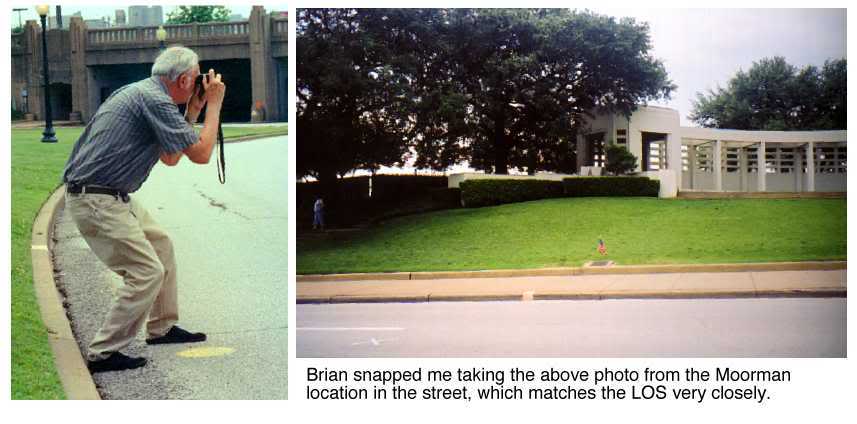
Think for a moment exactly what is being proposed.
The James Altgens photo taken at Zapruder frame 255 and showing the shadows of Moorman and Hill standing in the grass, show how crowded Elm Street was as the limousine passed.
![James Altgens photo taken at Zapruder frame 255 and showing the shadows of Moorman and Hill standing in the grass][Altgens with red text...](resources/James%20Altgens%20photo%20taken%20at%20Zapruder%20frame%20255%20and%20showing%20the%20shadows%20of%20Moorman%20and%20Hill%20standing%20in%20the%20grass%5D%5BAltgens%20with%20red%20text.jpg.opt818x624o0%2C0s818x624.jpg)
An earlier sweep by motorcycle officers was designed to move stray spectators out of the roadway. Two motorcycles on each side of the limousine patrolled the sides of the roadway. As the Altgens photo dramatically shows, the motorcycle outriders accompanying the limousine came within thirty inches of the south curb of Elm Street. If we are to believe that Mary Moorman jumped into the street to take her famous photo, we also have to believe that those officers, Martin and Hargis, veered their cycles suddenly to the right to miss her. Furthermore, this happened right in the middle of the assassination when spectators’ attention was riveted on the motorcade. Not a single witness later reported anything like this. Not a single witness reported seeing a spectator leap into street and almost get run down by two motorcyclists. Both Officers Martin and Hargis made reports and were later interviewed several times. Neither one said a thing about some crazy woman jumping into their path in the middle of the shooting and their having to veer around her. Is it remotely plausible that this happened and no one saw it or reported it?
What do the other photos of the assassination show?
![Does the Nix, Muchmore and Bronson films all show the same thing that the Zapruder film shows][Muchmore headshot AP...](resources/does%20the%20Nix%2C%20Muchmore%20and%20Bronson%20films%20all%20show%20the%20same%20thing%20that%20the%20Zapruder%20film%20shows%5D%5BMuchmore%20headshot%20AP.jpg)
The Nix, Muchmore and Bronson films all show the same thing that the Zapruder film shows. Martin and Hargis never veer their motorcycles but maintain their station off the left rear of the limousine. No one jumps into the street. Hill and Moorman can be seen standing quietly beside the curb as Moorman takes her picture. As indicated earlier, their shadows standing on the grass appear in the Altgens photo taken approximately three seconds before the Moorman photo. The Bronson still photo shows Hill and Moorman standing in the grass as the limousine approaches. The Moorman photo itself shows the motorcyclists cruising serenely by several feet from Moorman’s camera. As John Costella recently pointed out, all the photographic evidence (including the Moorman photo itself) confirms Moorman’s standing in the grass to take her photo. (NOTE: See http://groups.yahoo.com/group/jfk-research/message/6152)
Two other ingenious proofs have surfaced showing that the Moorman photo was taken from the grass not the street. Neither had anything to do with Fetzer and White’s failed LOS argument.
Bill Miller produced a test of supreme simplicity. First, he contacted the Harley-Davidson Museum and learned everything the Museum could tell him about the particular Harley model used in the Presidential motorcade. Nest, he was able to find via Ebay an actual Harley-Davidson motorcycle that had been used in the motorcade that day. Bill asked the owner to make a measurement for him after inflating the tires to their proper pressure and putting a 200 pound rider on the cycle. The owner measured the distance from the ground to the top of the motorcycle’s windscreen. It turned out to be 58”.
The Moorman photo is looking down from above on the top of Hargis’s windscreen. Hence, the Moorman camera has to be higher than 58" above the ground. Since the roadway is 8" lower than the grass, this would be the camera’s likely position if the photo were taken from the grass. Only if Mary Moorman jumped into the street and then raised the camera high above her head to take her picture could the Moorman photo have been taken from the street. Six or seven years ago, Miller and Robert Groden set up yellow staffs 58" high in the roadway at the position of the two motorcycle riders windscreens. They then photographed the yellow staffs from Moorman’s position in the grass as shown in the Zapruder film. Miller prepared this GIF that alternates between the Moorman photo and the 58" high staffs.
![Miller prepared this GIF that alternates between the Moorman photo and the 58 inch high staffs][58 inch stand test...](resources/Miller%20prepared%20this%20GIF%20that%20alternates%20between%20the%20Moorman%20photo%20and%20the%2058%20inch%20high%20staffs%5D%5B58%20inch%20stand%20test.gif.opt818x674o0%2C0s818x674.gif)
John Costella recently described a further test of which I was unaware. According to Costella, Rick Janowitz carried out an experiment suggested by Marcel Dehaeseleer. This happened in 2003. Costella described the experiment as a simple comparison of the field of view in the Moorman photo with the field of view produced by the same camera lens when placed in the street or placed in the grass. “If Mary were in the street,” wrote Costella on December 14, 2008, “you would not see as much background as if she were in the grass, simply because she was closer to everything in the background. Janowitz and Marcel (if their research was done as well as it seemed) proved that the field of view of the extant Moorman [photo] corresponds to that of a grass position, not a street position.” [NOTE: See http://groups.yahoo.com/group/jfk-research/message/6048. I have been unable to find any monograph or posting giving the results of this experiment.]
Archived for Posterity ... Courtesy of [http://www.jfklancer.com/moorman_essay/moorman_essay_3.html]
============================================================================
Archived for Posterity ... Courtesy of [http://www.jfklancer.com/moorman_essay/moorman_essay_4.html]
=================================================================
--------------------------------------------------------------------------------------------------------
Afterword
The claim we have examined in such detail probably does not deserve the attention it has received. It was based upon a simple mistake of observation: What Jack White said was present in the Moorman photo just wasn’t there! The importance of the claim, however, is what we can learn from its curious defense by Fetzer and White.
Remarkable about Fetzer and White’s defense of Moorman-in-the-street is that it comes a full six years after the claim was shown to be based on a careless reading of the Moorman photo. In the pages above, I have gone over many points. But these are not new. They were pointed out ad nauseum to Fetzer and White in, and since, 2002. The fact that their defense continues in 2009 signals a stubborn unwillingness on their part to engage with their critics. Over the last three months, Fetzer has proved a moving target. Once a single point was argued to a conclusion, he would introduce an extraneous point while never admitting the resolution of the first point. Again and again, he bombarded his critics and the public-at-large with alleged “proofs” that the Zapruder film has been falsified. When examined, the instances of proof end up being claims that Fetzer earlier made and were shown to be invalid. In this way, an invalid claim only gets buried to be resurrected again after people have forgotten its demise.
A second characteristic of the Fetzer-White defense is the proliferation of film alteration claims. The Moorman-in-the-street claim began with White and Fetzer claiming the Moorman photo was clearly genuine. As White put it in MIDP, “Because it was an instant photo that was copied and widely published within hours of the assassination, the Moorman Polaroid is guaranteed to be an authentic image.” However, as soon as it became apparent that the Moorman photo confirms Moorman’s position in the grass, we begin to hear about the likelihood of its alteration “especially in the area of the pedestal and the pergola.” Why would anyone care about altering the photo in this area? To conceal the fact that Zapruder and Sitzman never stood on the pedestal. Then what about the Betzner and Willis photos that clearly show persons dressed like Zapruder and Sitzman standing on the pedestal? Those photos were faked up too... And so it goes.
In 2009, on a the Education JFK assassination forum, Fetzer grandiloquently announced a new proof of Zapruder film fakery. Officer James Chaney gave an interview to ABC newsman Paul Good on the night of November 22nd saying he rode forward to inform the lead car about the shooting. Other reports by law enforcement officers seem to be saying the same thing. The Zapruder film shows no such thing, says Fetzer, hence the Zapruder film must have been altered. The Nix, Muchmore and Bell films show no such thing. Then they were altered too. A photograph taken by James Altgens shows no such thing. It was altered too.
Then Craig Lamson and others found additional photos of which Fetzer and White apparently were ignorant. The Daniel film and a still photo by Mel McIntire both matched the other films and showed Chaney trailing far behind the limousine. The McIntire still photo is particularly telling since it shows the Presidential limousine abreast of the lead car with the SS follow-up car close behind. Officer Chaney can be seen trailing about one hundred yards behind. Fetzer and White were asked repeatedly whether these photos were altered too. They declined to answer.
At the present time, it is not known whether Fetzer and White hold any of the Dealey Plaza photos to be genuine and unaltered. Their refusal to ever admit a mistake is comical. However, their ever-expanding claims of film alteration might have serious consequences, but only if they were believed.
Fortunately, it is clear this will not happen. Criticism already launched against the Fetzer-White claims has marginalized their efforts as far as the research community is concerned. Belief in alteration of the Zapruder film is generally looked upon as a kind of kooky religious belief. Meanwhile, Fetzer has moved on to the latest conspiration du jour.
The failure, however, of the Fetzer-White attack on the authenticity of the Zapruder film has had an unintended consequence.
There is a significant question concerning what evidence in the Kennedy assassination is to be considered authentic. The problems concerning the autopsy photos and x-rays hardly require mention. I believe there are significant questions regarding the provenance of CE 399 and perhaps other items of physical evidence. Eyewitness testimony is inherently unreliable and (as expected) in this case is filled with contradictions. Where then might we expect to find some bedrock of evidence in the case to use to evaluate the authenticity and significance of other evidence? Were Fetzer and White’s assault on the photo evidence from Dealey Plaza deemed successful, we would lose the photo record from Dealey Plaza as a source of vital evidence. The tabloid atmosphere already apparent on the internet could become permanent. Any claim could be launched because no body of evidence existed that could limit what might or might not be the case. Research on the case would be reduced to a cacophony of competing conspiracy theories each one contending that this or that piece of evidence was misleading because it had been altered.
For over a decade now, Fetzer and White have attempted to show discrepancies between the Zapruder film and other films and photos shot in Dealey Plaza. Their odd defense of Moorman-in-the-street is just part of this overall effort. Their effort is actually based upon a simple but incredibly powerful principle: Each photo and film taken in Dealey Plaza has to fit into a more general fabric. If you take photos and movies of a single event from multiple standpoints, all the films and photos have to agree. They can only vary with respect to the standpoint from which they were taken. For example, with respect to Mary Moorman, the Muchmore and Zapruder films show her from wildly different angles. Yet these films can be matched up frame-by-frame to lay out every detail of her actions as the limousine passes her. The same can be said of all the photos and films taken in Dealey Plaza. If a film or photo were altered, it would stand out. It would be discrepant with the rest of the photo record.
Because of the persistent but failing efforts of Fetzer, White and others, I can say with considerable confidence that the photo record from Dealey Plaza forms a seamless tapestry of what happened on November 22nd. If you want to know what happened there, then study the photo record. It is a self-authenticating whole that can stand as bedrock in the case. It can be used to evaluate both eyewitness testimony and physical evidence. Only by the sheerest luck did Abraham Zapruder climb up on that pedestal with his camera and Mary Moorman take her Polaroid along that day. Zapruder’s film and Moorman’s Polaroid (plus many other films and photos) give us the raw material to reconstruct the event insofar as it is possible. Without them, we in the research community would have gotten nowhere.
In the oddest way and against their will, the failure of Fetzer and White to defend their claims has provided a singular gift... a bedrock of evidence on which true research on the case can continue and thrive.
Josiah Thompson
Appendix A: What Mary Moorman said and didn’t say!
Mary Moorman has been interviewed numerous times by newsmen and law enforcement officers concerning what she saw and did on November 22nd. On that afternoon, she executed an Affidavit in the Sheriff’s Office. On February 15, 1969, she testified under oath in the Clay Shaw trial. I have collected below all the various statements of Mary Moorman I could find relevant to the question of her position when she took her famous photo. There probably are others. Without comment, I list them below for the record:
Affidavit Executed at the Sheriff’s Department on the afternoon of November 22nd
Moorman stated that “Mrs. Jean Hill and I were standing on the grass by the park on Elm Street... I had a Polaroid camera with me and was intending to take pictures of the President Kennedy and the motorcade.” She described taking two earlier photos. Then she stated:
As President Kennedy was opposite me, I took a picture of him. As I snapped the picture of President Kennedy, I heard a shot ring out. President Kennedy kind of slumped over. Then I heard another shot ring out and Mrs. Kennedy jumped up in the car and said, “My God, he has been shot.” When I heard these shots ring out, I fell to the ground to keep from being hit myself.” (19H487)
FBI Interview of Moorman at Sheriff’s Department on the afternoon of November 22nd
Moorman was interviewed by Special Agents Perryman and Gemberling on the afternoon of November 22nd. She described taking an earlier photograph of a police officer leading the motorcade. Then she described taking her famous photograph:
She took a second photograph of the President as his automobile passed her, and just as she snapped the picture, she heard what she at first thought was a firecracker and very shortly thereafter heard another similar sound which she later determined to have been gunfire. She knows that she heard two shots and possibly a third shot. She recalls seeing the President “sort of jump” and start to slump sideways in the seat, and seems to recall President KENNEDY’S wife scream, “My God, he’s been shot.” Mrs. MOORMAN states that she and her companion fell to the ground, but does not recall what prompted her to fall unless it was the reports and commotion in the President’s car. She says she must have instinctively realized that there was shooting, but does not recall actually thinking about it. She states that she could not determine where the shots came from, and her next recollection is of people running more or less aimlessly, it seemed to her. She recalls that the President’s automobile was moving at the time she took the second picture, and, when she heard the shots, and has the impression that the car either stopped momentarily or hesitated and then drove off in a hurry. (22H839)
NBC/WBAP interview of Hill and Moorman broadcast at 3:18 PM Dallas time*
* (Although broadcast at 3:18 PM Dallas time, this interview was filmed around 1:00 PM.)
Hill: Just as Mary started to take the picture and the President came right even with us, two shots – we looked at him and he was looking at a dog in the middle of the seat – two shots rang out and he grabbed his chest and a look of pain on his face and fell across Jackie and she, uh, fell over on him and said, “My God, he’s shot!” And there was an interval and then three or more shots rang out. By that time the motorcade sped away.
Interviewer: What prompted you to take the picture at that particular instant, Ma’am?
Moorman: Well, that’s the only chance I had. Mine is a Polaroid and I can take only one every ten seconds, and that was at that time when I took it.
Interviewer: Did you know he was shot?
Moorman: No, I didn’t. I must have snapped it immediately when he slumped, ‘cause in the picture that’s the way she’s there and he’s slumped over.
Interviewer: Did you see the person who fired the –?
Hill: No, I didn’t see any person fire the weapon. I only heard it. I looked up and saw a man running up the hill. No, I had no idea, nothing to go by, I mean I don’t think it dawned on me for an instant that the President had been shot. I mean, I knew and yet it didn’t register.
Interviewer: Did you get a look at the suspect, the assassin?
Moorman: No, I had taken a picture and then the shots and I decided it was time to fall on the ground. (Trask, "Pictures of the Pain", pp. 238-239)
KRLD Radio Interview of Mary Moorman, broadcast around 3:45 PM (local time) 11/22/63
The text of this interview was supplied by David Lifton to John Costella. Gary Mack listened to a Sixth Floor Museum copy of the original tape and supplied a critical part. The Lifton/Costella transcript stated: “Hogan: Were you up on that grassy bank there? Moorman: (unclear) stepped out. We were right at the car.” By listening to the Museum’s tape, Mack was able to correct Moorman’s answer to read: “Yes, that’s where we were and I stepped out in the street. We were right at the car.”
Jay Hogan: Hello, Mrs. Moorman?
Moorman: Yes.
Hogan: You took the picture just after the shooting, or just before?
Moorman: Evidently, just immediately, as the. . . Cause he was, he was looking, you know, when (ever?) I got the camera focused and then I snapped it in my picture, he slumped over.
Hogan: What type of picture was this.
Moorman: A Polaroid picture.
Hogan: About how close were you?
Moorman: (background talk, as she discusses it; can't make out)
Hogan: Fairly close.
Moorman: 10 or fifteen foot, I, no more (unintell). . . Because I fall behind my camera.
Hogan: This was right at the underpass?
Moorman: Yes, just a few feet from the underpass (continues, but she is cut off)
Hogan: Were you up on that grassy bank there?
Moorman: Yes, that's where we were and I stepped out in the street. We were right at the car.
Hogan: Uh Huh.
Moorman: (he has cut her off, and she is continuing). . . She (?). . . Hollered.
Hogan: Did you see any suspicious person, in conn. . . ?
Moorman: Yeah, of course, I have, I was just uh you know (unclear word) my camera, and when I took that the shots had rang out, and I wasn't looking around.
Hogan: How many shots did you hear? You say "shots rang out".
Moorman: Oh, oh, I don't know. I think three or four is what I, I uh, that I heard.
Hogan: Uh huh.
Moorman: (continuing) that I'm sure of. Now, I don't know, there might have been more. It just took seconds for it (for you to?) realize what was happening.
Hogan: Yeah, uh, what as your first thought?
Moorman: That those ARE shots. I mean, he had been HIT.
Hogan: Uh huh.
Moorman: And that they're liable to hit me, cause I'm right at the car, so I decided (unintelligible words) [safest place to be?? OR possibly: the place for me is to get on the ground??] (laughs)
Hogan: So huh, how did the president respond to this shot. I mean, did he just slump suddenly?
Moorman: He grabbed his chest, and of course, Mrs. Kennedy jumped up immediately, and fell over him; and she said: "My God, he's been shot.”
ABC/WFAA interview of Mary Moorman filmed late in the afternoon of 11/22/63
Bill Lord: Did you realize what had happened when you heard the shots?
Mary Moorman: No, I didn’t. There was, oh, three or four real close together and it was, uh, it must have been the first one that shot him because that’s when I, that was the time I took the picture, and during that time, after I took the picture, and the shots were still being fired, I decided I’d better get on the ground.
Lord: Did people lie down on the ground?
Moorman: Uh, I just know about myself and the ones right close to me, and really, I just know about myself.
Lord: You did lie down?
Moorman: I did. We were, I was no more than 15 foot from the car and in the line of fire evidently.
(Note: Trask cites a portion of this interview at page 239 of "Pictures of the Pain". Gary Mack was kind enough to make a transcript of the original filmed interview and provide additional dialogue.)
The Warren Report (9-27-64) (CBS-TV News Special) (Part 10) Walter Cronkite narrator, 3:33 - 3:53 seconds into Segment 10.
Moorman is filmed standing in the grass by the south curb of Elm Street. Whatever question prompted her response is cut edited. We have only the following words from her:
Moorman: I stepped out into the street so I took the camera and aimed it, uh, focused it and stood there and looked through it for quite a few seconds because I wanted to be sure they were looking at me. And, uh, I followed it for, uh, so many seconds and then I did take the picture.
(3:32 - 3:53) (NOTE: See http://www.youtube.com/watch?v=IXNXotif5J8.)
February 15, 1969, Moorman’s Sworn Testimony at the Shaw Trial
Moorman was asked to identify her famous photograph and did so. She was asked to “pin this flag on the location, your location, in Dealey Plaza on November 22, 1963." After doing so, she was shown a large mock-up of Dealey Plaza and once again asked to place herself in the mock-up. She did so. (NOTE: The Court transcript, of course, does not indicate where she pinned the flag on the exhibit or placed herself in the mock-up. Since, a few minutes later, she identified herself in the Zapruder film in the grass by the curb, there is no reason to believe that she placed herself anywhere else on the exhibit or in the mock-up.)
Next, she was asked what she saw and heard on November 22nd and replied:
“I observed the motorcade as it approached. There were several cars preceding the Presidential limousine, and, as the Presidential limousine approached me, I stepped forward to observe closer in order to take a picture, that is what I planned to do and just what I did.” (36)
Finally, the Zapruder film was shown and she was asked to “locate yourself in the picture... please walk to the film and point to yourself.”(45) She pointed herself out as she appears standing in the grass taking her photo in Zapruder frames 291-313.
KRLD interview of Moorman in 1997
Moorman: Uh, just immediately before the presidential car came into view, we were, you know, there was just tremendous excitement. And my friend who was with me, we were right ready to take the picture. And she’s not timid. She, as the car approached us, she did holler for the president, “Mr. President, look this way!” And I’d stepped out off the curb into the street to take the picture. And snapped it immediately. And that evidently was the first shot. You know, I could hear the sound. And...
Charley Jones: Now when you heard the sound, did you immediately think “rifle shot?”
Moorman: Oh no. A firecracker, maybe. There was another one just immediately following which I still thought was a firecracker. And then I stepped back up onto the grassy area. I guess just, people were falling around us, you know. Knowing something was wrong. I certainly didn’t know what was wrong. ("Murder In Dealey Plaza," 346)
One can speculate endlessly about what a witness says in an interview. With regard to Moorman, it is clear that in her KRLD interview from 1997 she says she took her famous photo from the street. A twenty-second sound bite from CBS’s 1964 Warren Report broadcast has her saying the same thing. However, it is equally clear that this has not always been her story.
In her Sheriff’s Department Affidavit from the afternoon of November 22nd, she tells of taking her picture, and, “when I heard these shots ring out, I fell to the ground to keep from being hit myself.” To FBI agents Perryman and Gemberling, she said the same thing that afternoon:
She took a second photograph of the President as his automobile passed her, and just as she snapped the picture, she heard what she at first thought was a firecracker... Mrs. MOORMAN states that she and her companion fell to the ground but does not recall what prompted her to fall unless it was the reports and commotion in the President’s car... She states that she could not determine where the shots came from and her next recollection is of people running more or less aimlessly
In her NBC/WBAP-TV interview filmed around 1:00 PM (CST), she says,
“I had taken a picture and then the shots and I decided it was time to fall on the ground.”
In her ABC/WFAA-TV interview from that afternoon, she says,
“... I took the picture, and, during that time, after I took the picture and the shots were still being fired, I decided to get on the ground.”
The interviewer, Bill Lord, asks her if she lay down and she replies:
“I did. We were, I was no more than 15 foot from the car and in the line of fire.”
In her 1969 sworn testimony at the Shaw trial, Moorman identified herself in the Zapruder film standing in the grass taking her photo and indicated her “location in Dealey Plaza” on both a map and a mock-up of the Plaza.
All of these remarks and sworn testimony are confirmed by later pictures showing Hill and Moorman seated on the grass at the spot where earlier film and photos show them standing as Moorman snaps her photo.
Fetzer and White have made much of a remark made by Moorman during a radio interview carried out on the afternoon of November 22nd. The crucial segment of that interview runs like this:
Moorman: ... I got the camera focused and then I snapped it in my picture, he slumped over.
Hogan: What type of picture was this.
Moorman: A Polaroid picture.
Hogan: About how close were you?
Moorman: (background talk, as she discusses it; can't make out)
Hogan: Fairly close.
Moorman: 10 or fifteen foot, I, no more (unintell). . . Because I fall behind my camera.
Hogan: This was right at the underpass?
Moorman: Yes, just a few feet from the underpass (continues, but she is cut off)
Hogan: Were you up on that grassy bank there?
Moorman: Yes, that's where we were and I stepped out in the street. We were right at the car.
Hogan: Uh Huh.
In this transcript, Moorman does not say she took her famous photo from the street. On the contrary, she says “I fall behind my camera” [onto the grass]. When asked where she was standing, she says she was “on that grassy bank there” and goes on to say, “That’s where we were and I stepped out in the street.” Moorman does not say that she “stepped out in the street” to take her photo but only that she “stepped out into the street” at some point. That point could have been significantly before the limousine arrived opposite her or in the seconds after it passed.
In essence, what we have here is a dilemma that commonly surfaces in dealing with eye-witness accounts of an event. The contents of a photo or tape recording does not change over time. A person’s verbal account of what they saw or did, however, often does. In cases like this, one is faced with deciding between two conflicting statements: Was she in the street or in the grass when she took her famous photo?
In like circumstances, we would normally ask what other people observed. One could easily imagine a dialogue occurring like this:
A: Did anyone else see her jump into the street to take her photo?
B: No, none of the several hundred witnesses in the Plaza reported that they saw her jump into the street to take her photo. The two police motorcyclists would have had to dodge around her and they said nothing like that.
A: What about other films and photo? Do they show her jumping into the street?
B: No, they show just the opposite. The Zapruder, Muchmore, Nix and Bronson films all show her standing in the grass calmly snapping her photo as the limousine and motorcyclists cruise by serenely. The Bronson still photo was taken a few seconds before her photo and shows her standing in the grass. The Altgens still photo (taken three seconds before her photo) shows the shadows of Moorman and Hill standing in the grass. A: Well, how about the photo she took? There ought to be internal evidence in it as to where it was taken from... the grass or the street? Is there?
B: There is abundant evidence in the photo itself that shows unequivocally it was taken from the grass.
A: Well, there doesn’t seem to be any doubt does there? It was taken from the grass.
As a matter of fact, this instance provides a fine example as to how the photo record from Dealey Plaza can be used effectively to resolve conflicts in eyewitness reports.
Why would Mary Moorman end up making confusing and conflicting statements as to where she was when she took her famous photo? I have a suggestion. It concerns the position she occupied in taking one – and perhaps two – of her earlier photos that afternoon.
Before the limousine arrived, Moorman snapped two photos of motorcyclists preceding the limousine. The first was of Officer G. C. McBride, a good friend of Moorman’s from high school days, who was riding in the advance guard that day. Her photo of him shows the officer looking straight into the camera with the Depository looming in the background. Internal evidence in the photo shows it was taken from a position in the street, looking up at the 58" high top of McBride’s windscreen.
![A second photo was taken by Moorman of another school friend, Officer W. George Lumpkin][McBride photo by Moorman...](resources/A%20second%20photo%20was%20taken%20by%20Moorman%20of%20another%20school%20friend%2C%20Officer%20W.%20George%20Lumpkin%5D%5BMcBride%20photo%20by%20Moorman.jpg)
A second photo was taken by Moorman of another school friend, Officer W. George Lumpkin, who lost the photo after Moorman gave it to him. Richard Trask interviewed Lumpkin in 1978. Lumpkin recalled Moorman taking the photo about two minutes before the assassination. “He thinks he stopped on Elm Street,” wrote Trask, “and briefly spoke with Moorman and Hill.” [NOTE: Trask, op. cit. , p. 234]
The fact that Lumpkin recalls stopping on Elm Street and talking with Moorman suggests that this photo too was taken from the street. If so, two out of the three photos she took that day were taken after she “stepped out in the street.” She may well have confused these two excursions into the street well ahead of the limousine with the taking of her famous photo. What remains in Moorman’s memory must be subject to speculation. What is not subject to speculation, however, is the indisputable fact that internal evidence in the photo itself, as well as abundant other photo and eyewitness evidence, demonstrates that it was taken from the grass not the street.
Archived for Posterity ... Courtesy of [http://www.jfklancer.com/moorman_essay/moorman_essay_4.html]
============================================================================================================================
============================================================================================================================
Now ... to be fair .... let's give the Original Researcher & Photo Analyst Jack White ... equal time to make his claims ...
The Great Zapruder Film Hoax [Researcher and Photographic Analysist Jack White
The Great Zapruder Film Hoax [Researcher and Photographic analyst Jack White]
[Published on Jul 20, 2012]
Uploaded Courtesy of Brad Veilleux [https://www.youtube.com/channel/UCxRrR2EiGNF6bHJ4O7XKrnQ]
Even this film has noticeable cuts and bruises. Our adversary will never stop diligently laboring to prevent us from learning the truth.
Watching the tremendous amount of the cover-up work done on the Internet today, one may begin to appreciate what the "Big Government" term really means.
Trying to estimate the cost of the cover-ups, one may come in touch with the physical embodiment of the abstract term "unlimited resources" and how deeply can affect everyone's life those that own the money printing presses.
Better read the book: http://www.amazon.com/The-Great-Zapru...
*** Uploaded and described by AlBoesch on Jul 5, 2009
"Scientists examined the Zapruder film. They found that, while most of it looks completely genuine, some of the images are impossible. They violate the laws of physics. They could not have come from Zapruders home movie camera.
Zapruders film is a very good forgery. It is almost perfect. Some mistakes took almost 40 years to find.
The scientists also proved that Zapruders film was not just changed a little bit. The whole film is a fake!
A movie film is just a strip of little photos (frames). The fake film was made by cutting and pasting real photos and film frames together to make new frames.
Because the Zapruder film is only 27 seconds long, less than 500 photos needed to be made. The forgers had almost a year to create them, before they were published. This was not difficult to do in 1963 and 1964. People had been creating high quality fake photos since the 1850s!
But what about the people who watched Zapruders film in the days after the assassination?
Film experts believe that a real film of the assassination was quickly altered on the evening of the assassination, using machines that could create Hollywood-style special effects (like Mary Poppins, created in 1964). Since the film was not shown on television, no one knows exactly what these people saw. But we do know that they described a film that is different to the film published in November 1964 as the Zapruder film!
In May 2003, scientists and researchers presented their latest findings at a conference in Duluth, Minnesota. This has now been described in a book, The Great Zapruder Film Hoax, published in September 2003.
The web pages below describe the best proofs that the Zapruder film is a fake. They describe some of the mistakes that the forgers made.
You can save any of these web pages by going to the File / Save As menu on your web browser. The images and small movie clips shown on each page will also be automatically saved with each web page.
If you want more details, please read The Great Zapruder Film Hoax. It contains much more information about the Zapruder film and its forgery. An earlier book, Murder in Dealey Plaza, has more information about the whole assassination and its cover-up.
In the end, you have to decide for yourself what to believe. But dont just believe what the U.S. Government tells you! * * * * * COPYRIGHT NOTICE: Video uploaded for nonprofit, educational purposes only under the "fair use" provision of U.S. Code, Title 17, section 107."
===========================================================================================
Additional Reference Videos from the Zapruder Film Symposium, University of Minnesota, May 2003
[http://www.assassinationscience.com/UNDchapter/VideosJFK3.html]
ZAPRUDER FAKERY 1 - James H. Fetzer
ZAPRUDER FAKERY 2 - John Costella
ZAPRUDER FAKERY 3 - David Healy
ZAPRUDER FAKERY 4 - David W. Mantik
ZAPRUDER FAKERY 5 - Jack White
ZAPRUDER FAKERY 6 - David Lifton
============================================================
THE FAKE ZAPRUDER FILM [9.59] [UPLOADED ON OCT 26, 2010]
THE FAKE ZAPRUDER FILM [9.59] [UPLOADED ON OCT 26, 2010]
[https://www.youtube.com/watch?v=5BEsAkXVeVM]
On November 22, 1963, U.S. President John F. Kennedy was shot and killed while traveling down Elm Street, Dallas, Texas, in an open car in a motorcade. Everyone agrees about that.
Many people think that agencies of the U.S. Government have lied about or covered up details of the assassination.
For three decades, people thought the best proof of foul play was a 27-second home movie of the assassination taken by a Dallas dressmaker, Abraham Zapruder. It shows JFK's head being blasted backwards and to his left:
This seems to tell us that the shooter was in front of the car on the right side, on the "grassy knoll" (small hill) next to Elm Street. But the U.S. Government insisted that JFK was shot by just one man hiding in a building far behind the limousine.
Things get more complicated when we look at the film frame-by-frame. As the bullet hits, JFK's head first moves forwards:
This makes things confusing. There seemed to be three possible explanations:
1. He was hit by two bullets at almost the same time (one from behind and then one from the front).
2. He was hit from behind, and a jet of brain matter exploding from the front caused his head to recoil backwards.
3. He was hit from behind and some sort of muscle reaction caused his head to fly backwards.
People tried to figure this out for three decades. Instead of clearing up the mystery, Zapruder's film just made things more confusing.
In the 1990s, researchers started to realize that there was a fourth possible explanation. Zapruder's film might also be a part of the lies and cover-up that agencies of the U.S. Government had weaved around the JFK assassination!
Scientists examined the Zapruder film. They found that, while most of it looks completely genuine, some of the images are impossible. They violate the laws of physics. They could not have come from Zapruder's home movie camera.
Zapruder's film is a very good forgery. It is almost perfect. Some mistakes took almost 40 years to find.
The scientists also proved that Zapruder's film was not just changed a little bit. The whole film is a fake!
A movie film is just a strip of little photos ("frames"). The fake film was made by cutting and pasting real photos and film frames together to make new frames.
Because the Zapruder film is only 27 seconds long, less than 500 photos needed to be made. The forgers had almost a year to create them, before they were published. This was not difficult to do in 1963 and 1964. People had been creating high quality fake photos since the 1850s!
But what about the people who watched Zapruder's film in the days after the assassination?
Film experts believe that a real film of the assassination was quickly altered on the evening of the assassination, using machines that could create Hollywood-style special effects (like Mary Poppins, created in 1964). Since the film was not shown on television, no one knows exactly what these people saw. But we do know that they described a film that is different to the film published in November 1964 as the "Zapruder Film"!
more info:
[http://assassinationscience.com/johncostella/jfk/intro/]
[http://www.baltimorechronicle.com/zapruder.html]
JFK Symposium: "The Zapruder Film: Is Seeing Believing in the Assassination of JFK?"
[http://www.assassinationscience.com/UNDchapter/VideosJFK3.html]
ZAPRUDER FILM 1080P HD 12 JFK EUR VERSION KENNEDY DEATH DALLAS [PUB. ON JUN 17, 2015]
ZAPRUDER FILM 1080P HD 12 JFK EUR VERSION KENNEDY DEATH DALLAS [PUBLISHED ON JUN 17, 2015]
Credit to Stephenson Evaristo
-------------------------------------
The tragic Zapruder Film in high quality 1080p HD , stabilized, SlowMoed and cleaned, from the french copy with enhanced sound ( there was no Audio on Zapruders Cam)...plus aftermath footage by Mark Bell and more.
Show simultaneous synced headshots, including one exploding on impact bullet that hit the peace loving presidents head.
The fact alone, that different kinds of Bullets were in use, proves that more than one weapon was fired.
On June 4, 1963, a Presidential decree, Executive Order 11110, was signed with the authority to start, basically strip the FED (Central Bank) of the power to loan money to the United States Government at Interest. With the stroke of a pen, President Kennedy declared that the privately owned Federal Reserve Bank would soon be out of business. This would have been the start of returning to the federal government, the Constitutional power to create and issue currency -Money - without going through the Federal Reserve Bank and paying Interest for it, which brought the world to all the depts in the first place. But President Kennedy was brutally assassinated on November 22, 1963 and the United States Notes, he just had issued, were no longer produced and the ones that fell into the hands of Banks were taken out of circulation. So JFKs Executive Order 11110 wasn't executed anymore after his death.
The assassination of JFK was a warning to all future presidents not to interfere... It seems very apparent that Kennedy challenged the "powers that exist behind the U.S. and most other Goverments". With true patriotic courage, JFK boldly faced the most successful vehicles that have ever been used to drive up debt, and create Doh, for the few, at the same time :
- His efforts to have all U.S. troops out of Vietnam by 1965
- combined with Executive Order 11110 would have, in long term destroyed the profits and control of the Federal Reserve Bank and the people behind it.
- Nuclear warfare including: JFK did not allow Israel to develop Nuclear Weapons. LBJ reversed this U.S. policy, once he became president.”
for more information read a book like;
- for more on the FED read Eustace Mullins truely classic Book on the "Federal System" for free here – [http://k002.kiwi6.com/hotlink/2ip27py484/eustace_mullins_-_the_secrets_of_the_federal_reserve_the_london_connection.pdf]
- or only available in french Maurice Phillipps new book - De Dallas a Montreal
- Michael Collins Piper’s basic Book, Final Judgment - free pdf at: [http://www.wikispooks.com/w/images/f/f6/Final_Judgment.pdf]
==========================================================================================================================
============================================================================================================================
============================================================================================================================
============================================================================================================================
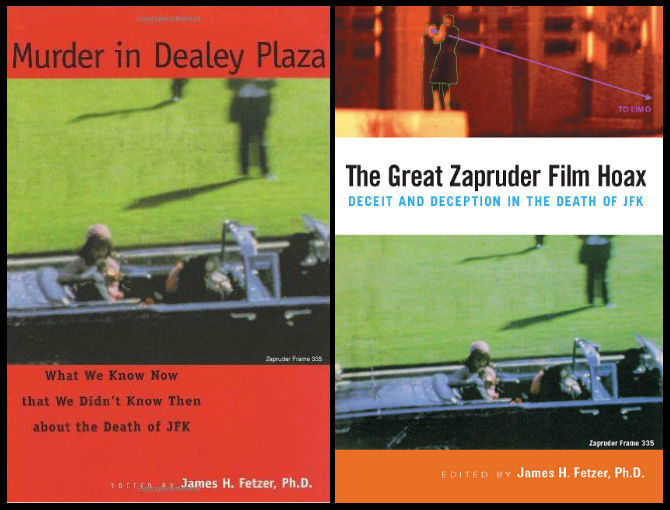
ASSASSINATION SCIENCE : EXPERTS SPEAK OUT ON THE DEATH OF JFK (1998)
MURDER IN DEALEY PLAZA: WHAT WE KNOW NOW THAT WE DIDN'T KNOW THEN (2000)
THE GREAT ZAPRUDER FILM HOAX: DECEIT AND DECEPTION IN THE DEATH OF JFK (2003)
PROFESSOR JAMES H. FETZER Ph.D.
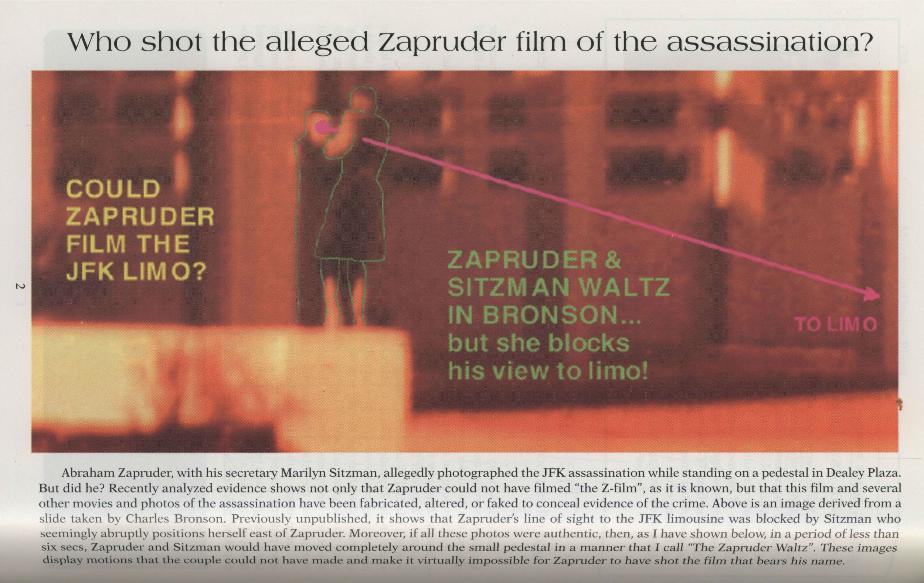
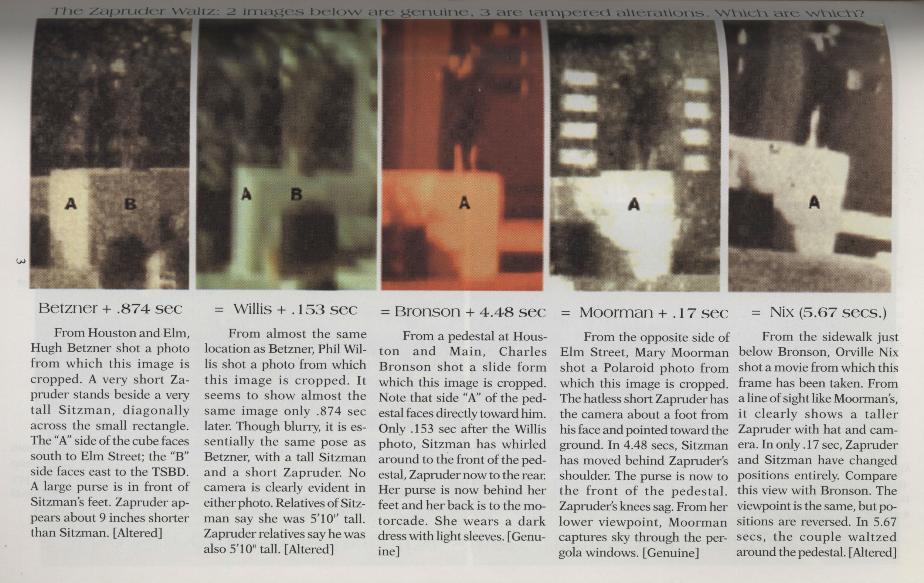
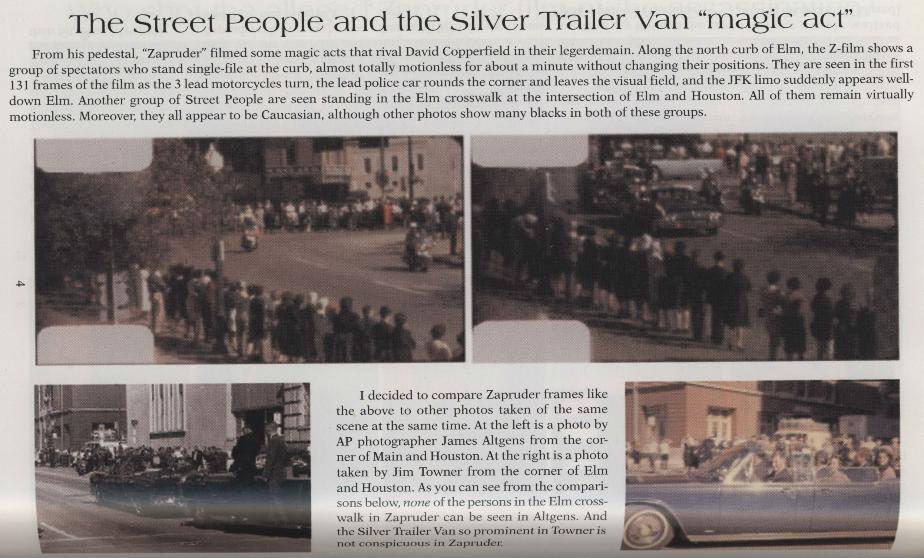
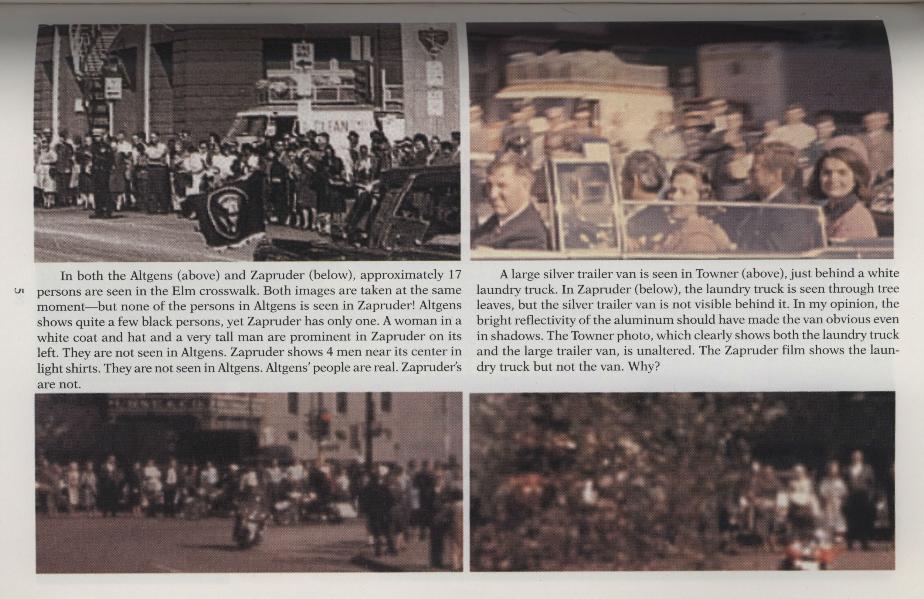


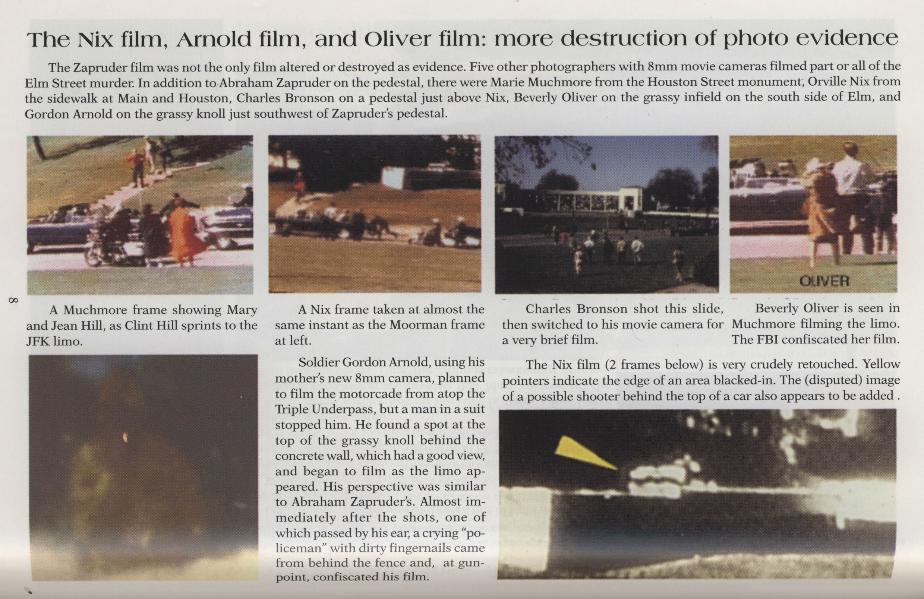
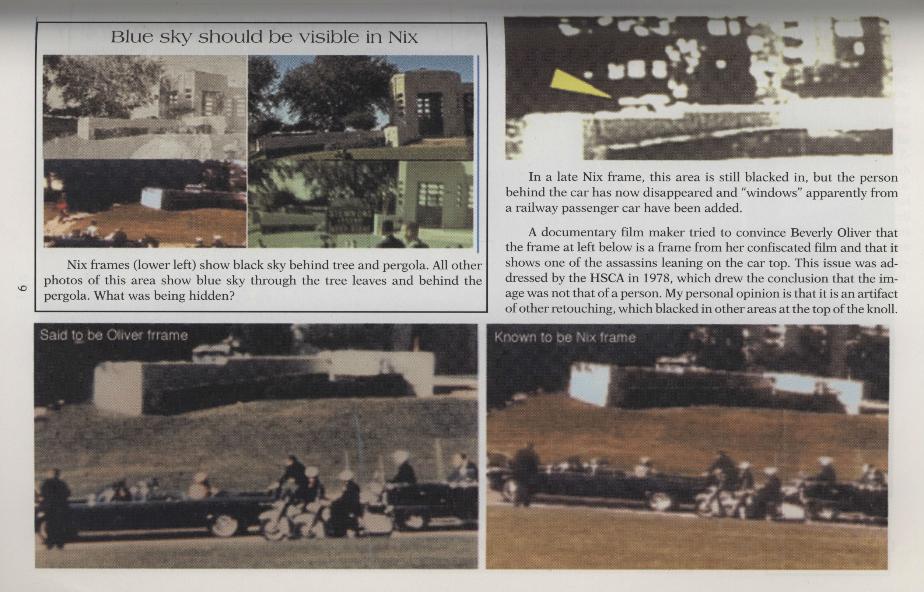
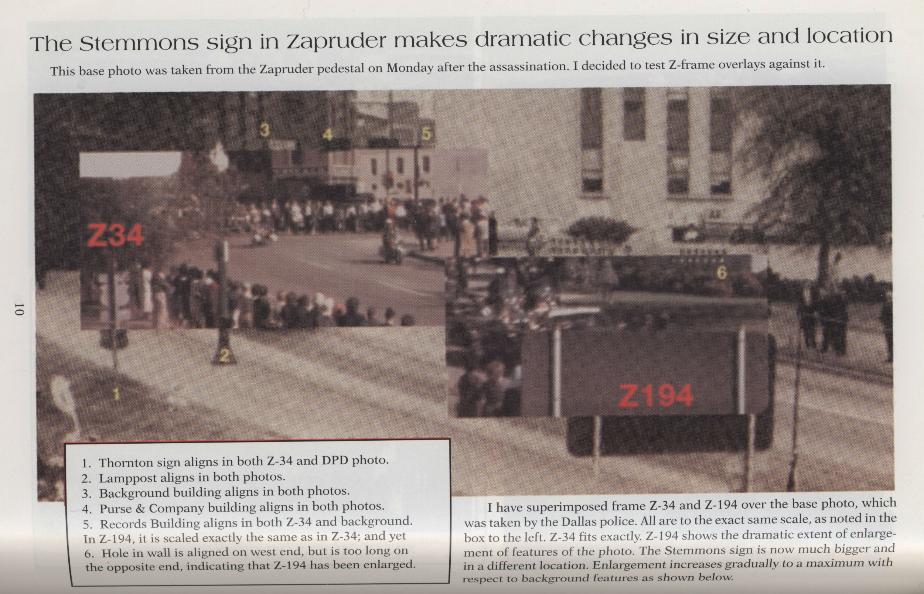

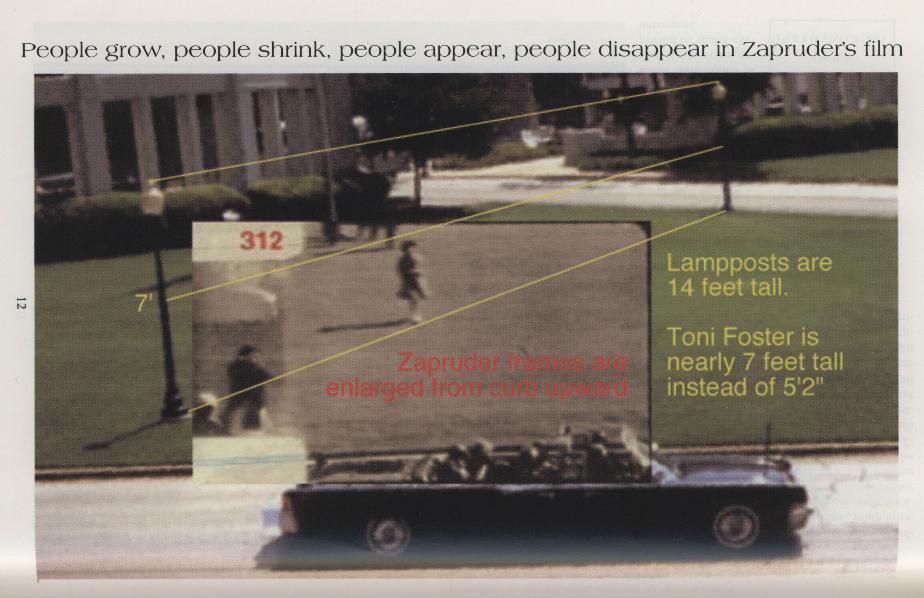
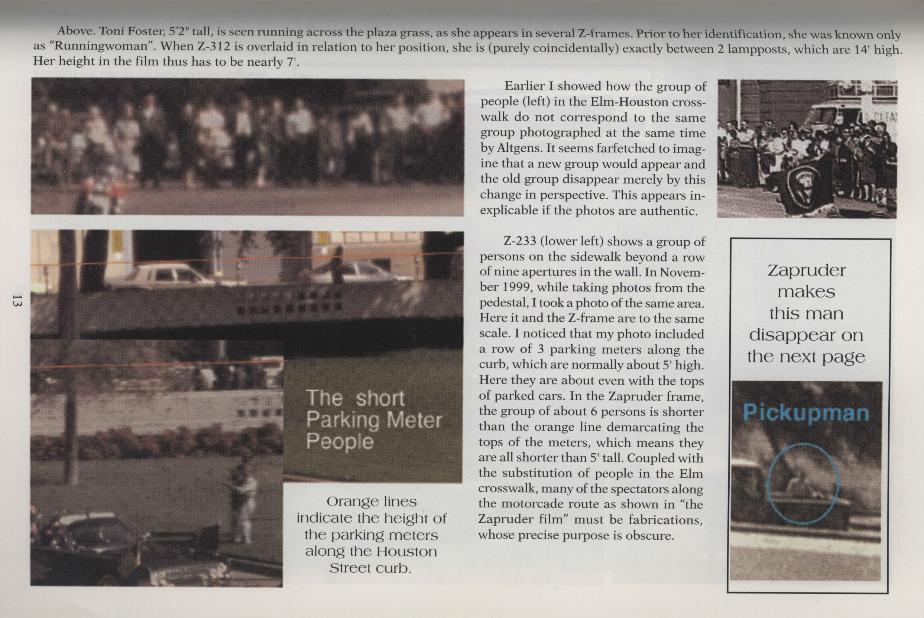
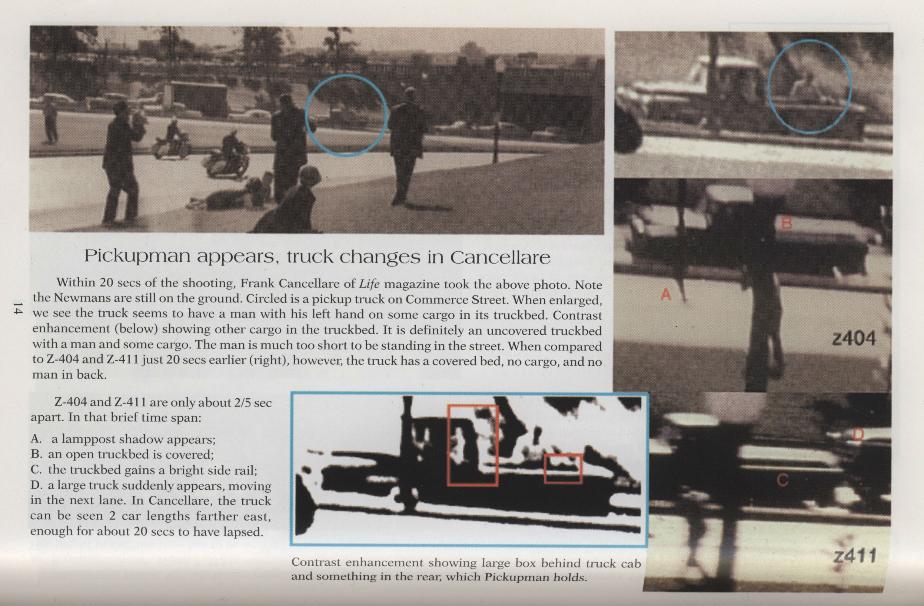
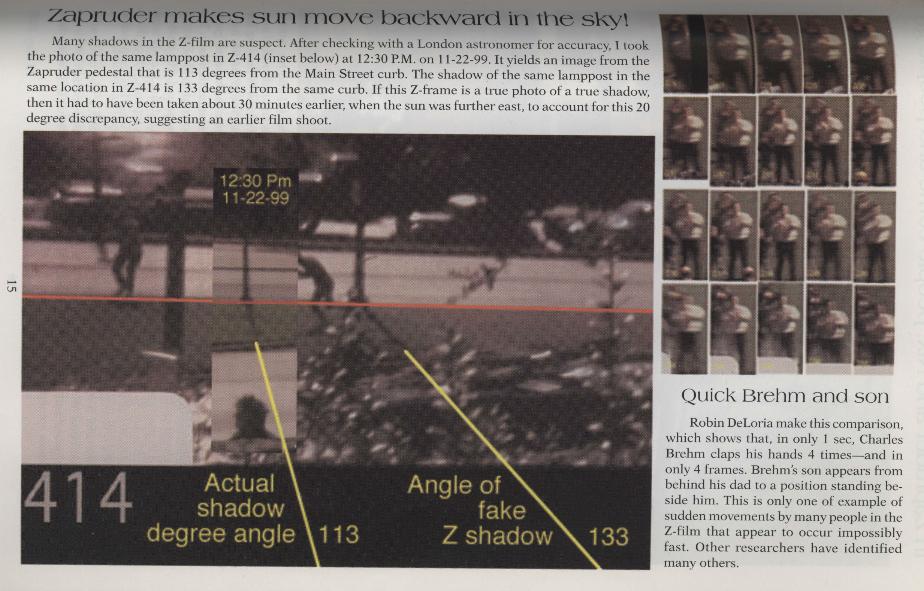


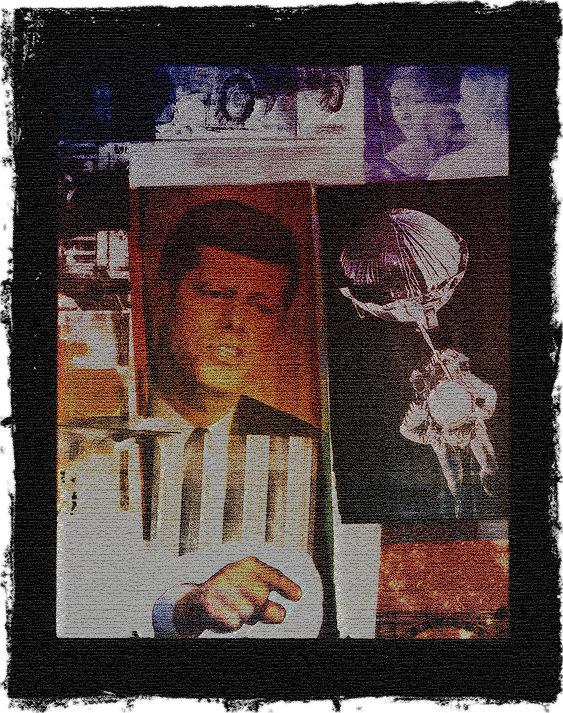
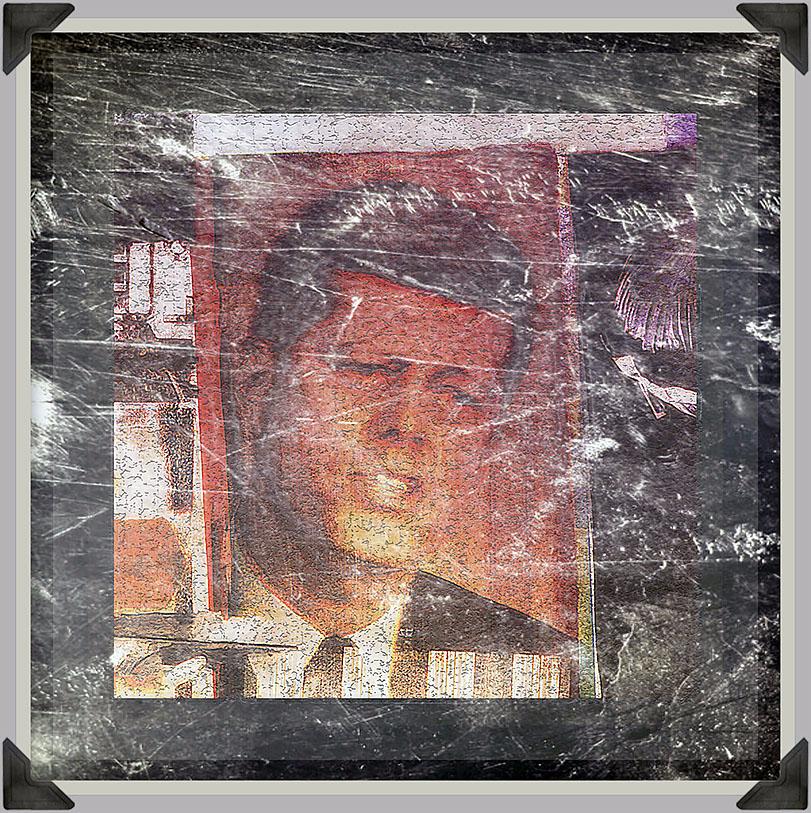










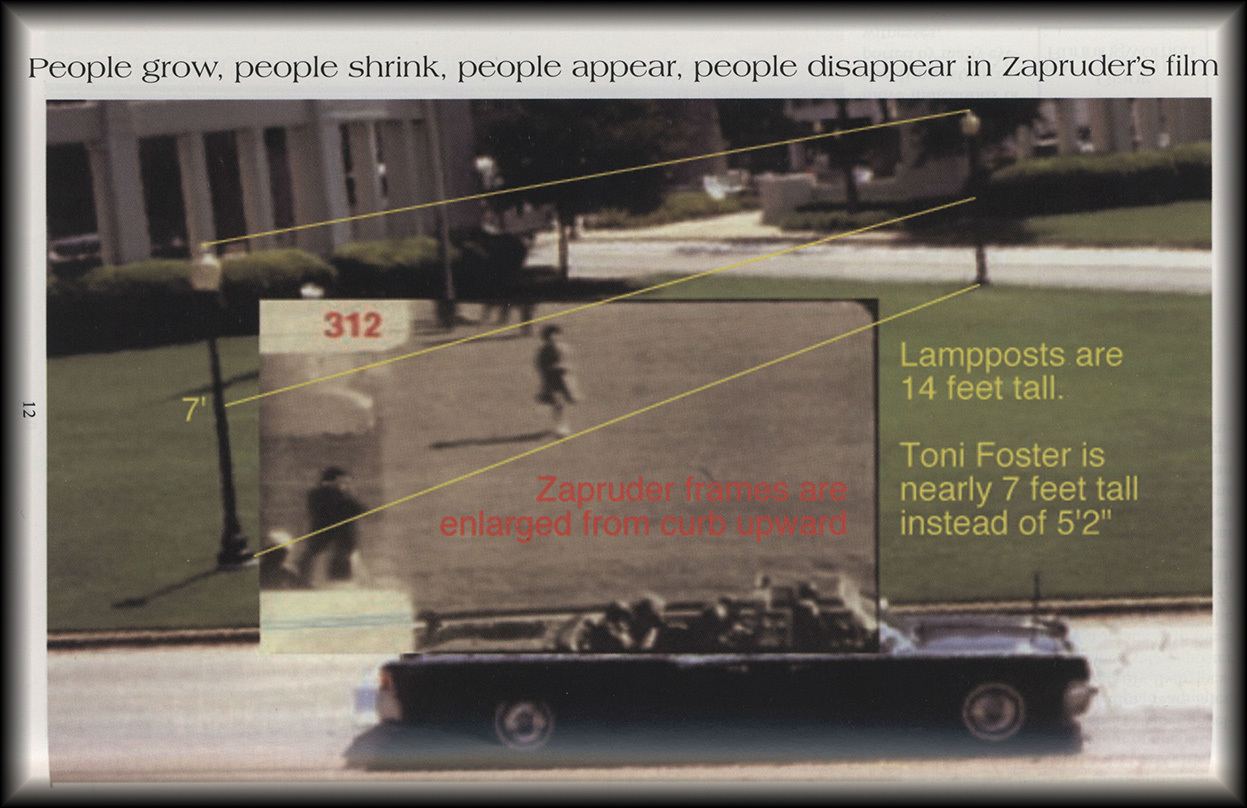


![JFK Lancer Logo][President John F. Kennedy News and Research](resources/JFK%20Lancer%20Logo%5D%5BPresident%20John%20F.%20Kennedy%20News%20and%20Research.jpg)
